This art exhibit has been organized by Father Francesco Cucchi with artwork items from private collections.
Immerse yourself in the beauty of Italian artisan works that were created by artists that are well-known, not so well-known and in some cases are unknown.
The Exhibit features Italian style artworks from the 16thto 20thcentury.
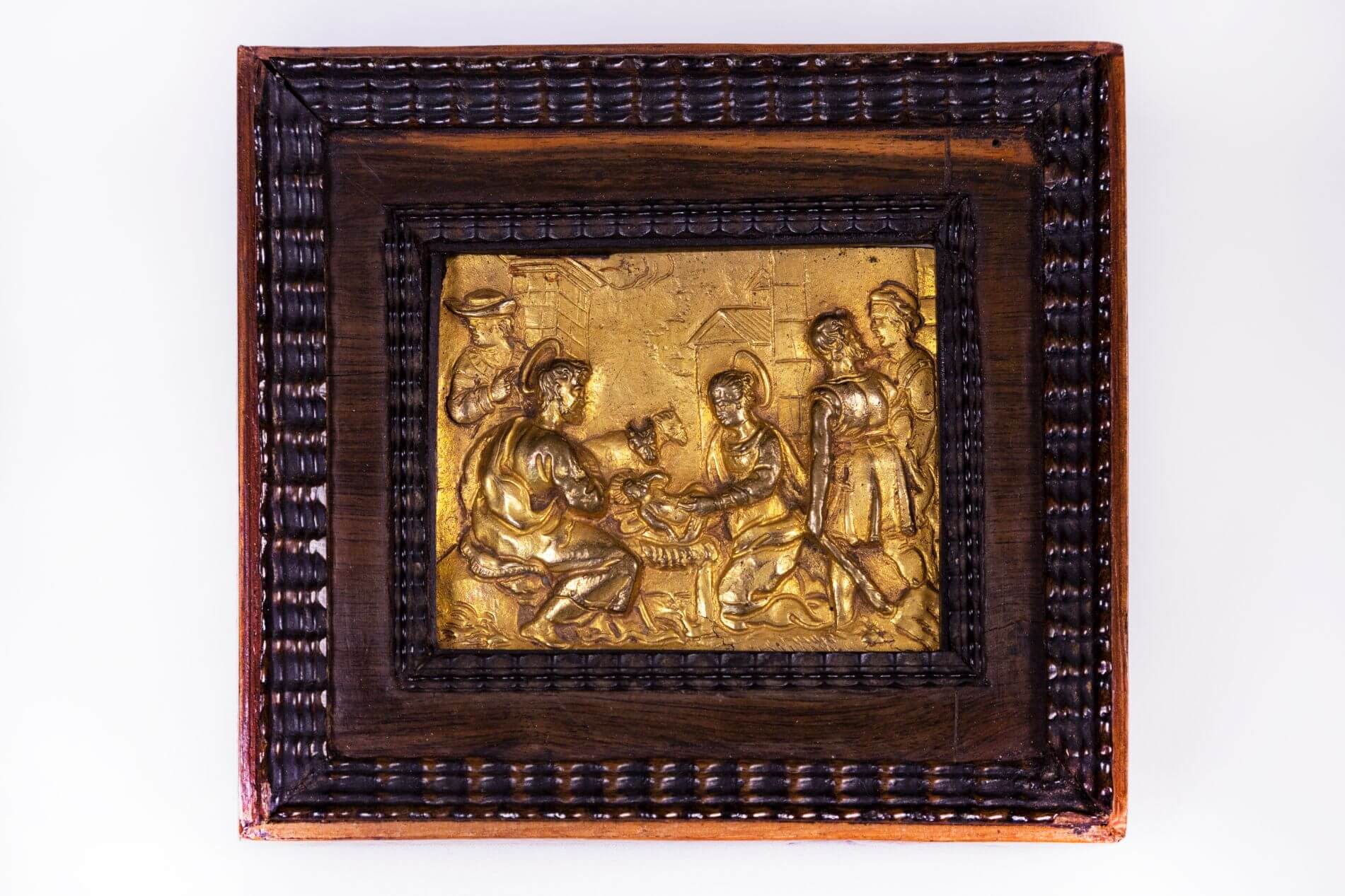

🗓 Second half of XVI century
📍 North of Italy
🏆 Bronze golden gilded, 7x6cm
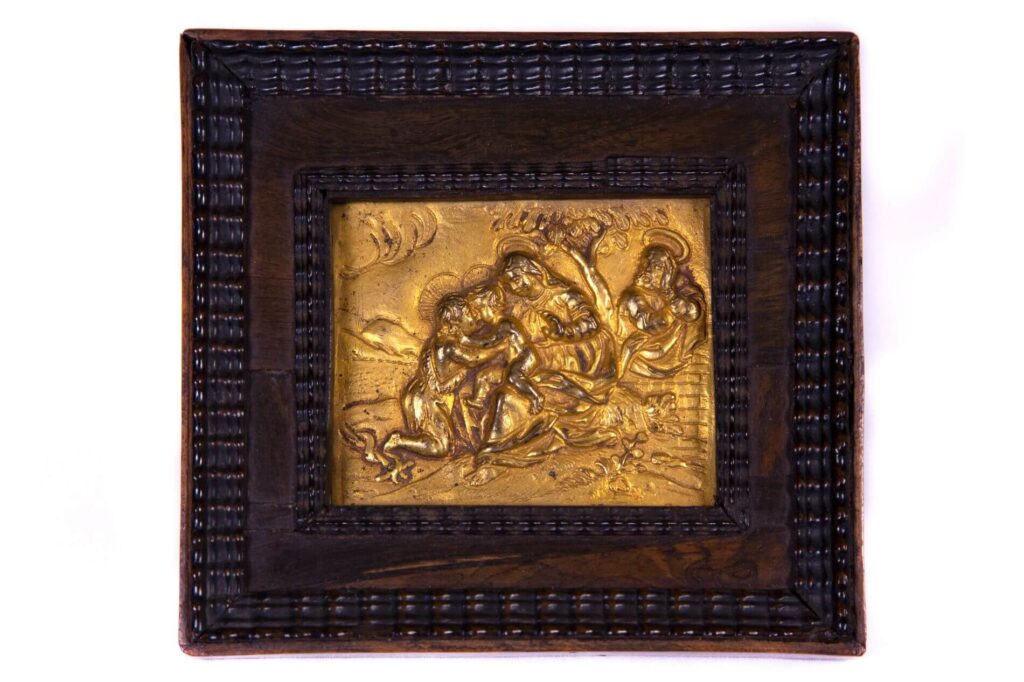

These plaques are a typical example of artwork from late XVI century depicting a style that is quite simple; however, intricate techniques have been used. Indeed, there is a fusion with bronze, and after that the artist refined his job, carving the metal to evolve the people, their hair, the vestments, buildings and every detail in the scene. In two different ways, the author tried to show perspective, drawing the buildings and the background, and keeping the main character with the fusion far from the main surface. From the back side, one can figure out why these molds were created.
These plaques were designed for personal devotion, and something that people could buy in the silversmith shop. The gold on the surface was attached with an old system: the author added real gold to mercury, and painted the bronze, after that he cooked it in an oven. During this process, the mercury left like gas, and the gold strongly attached to the bronze. The beautiful frames were made in XIX century, and these plaques are in a very good condition with the original gold.
This little bucket is composed of a handle which was made with a silver fusion using a mold; and only later refined, and the body of this object is made with one foil of silver. The great importance of this secchiello is related to the technique used by the silversmith. He made the body working only with one foil of silver, very thin, and he was able to produce such a significant decorative object.
The secret of the technique was in keeping it very warm the foil and not putting it on a pitch. The decoration is made carving the foil after the work with the pitch. The motif of this decoration is with flowers, and leaves. In the handle, we can see the silver mark of Venice (Leone in moleca, and of the silversmith (Z) probably the initial of his last name.
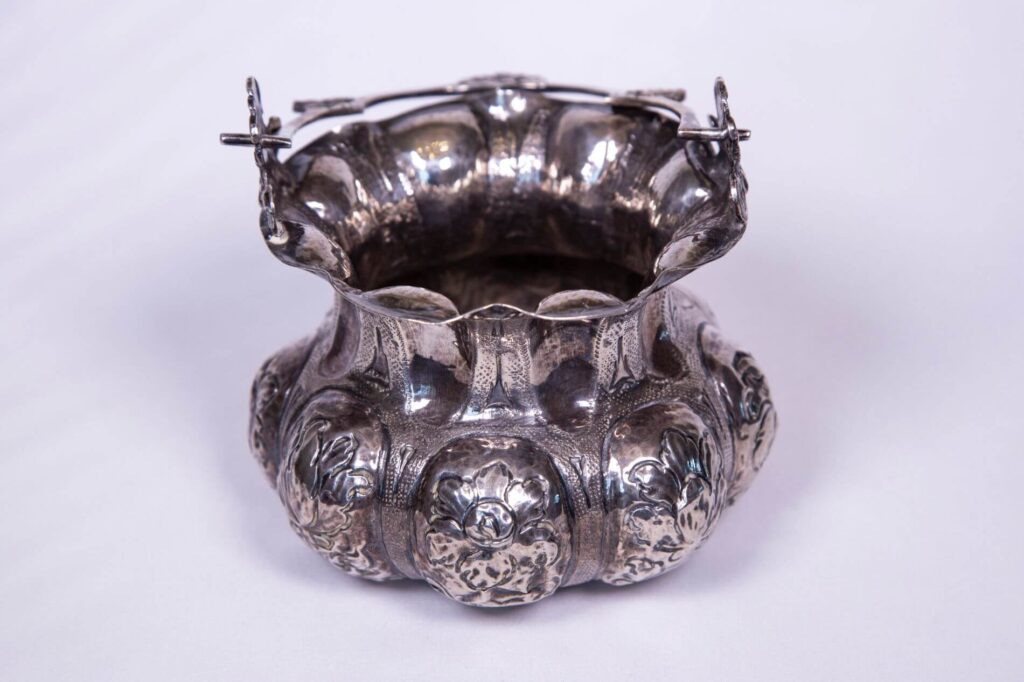

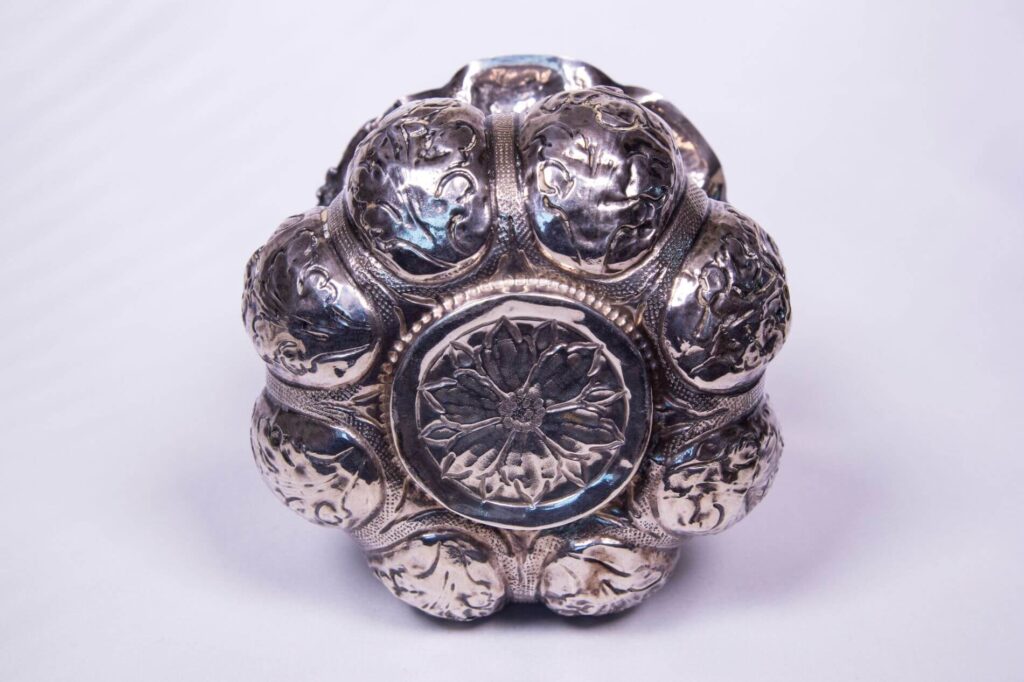

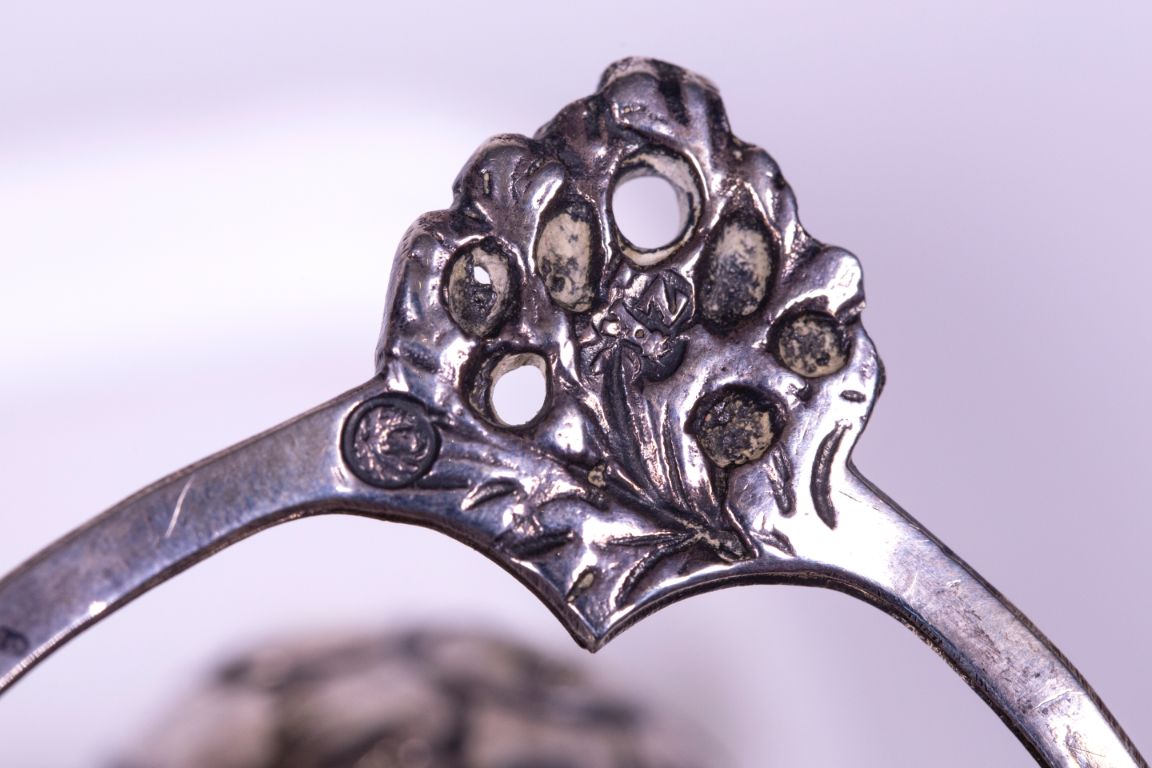

🗓 Second half of XVI century
📍 North of Italy
🏆 Bronze golden gilded, 7x6cm
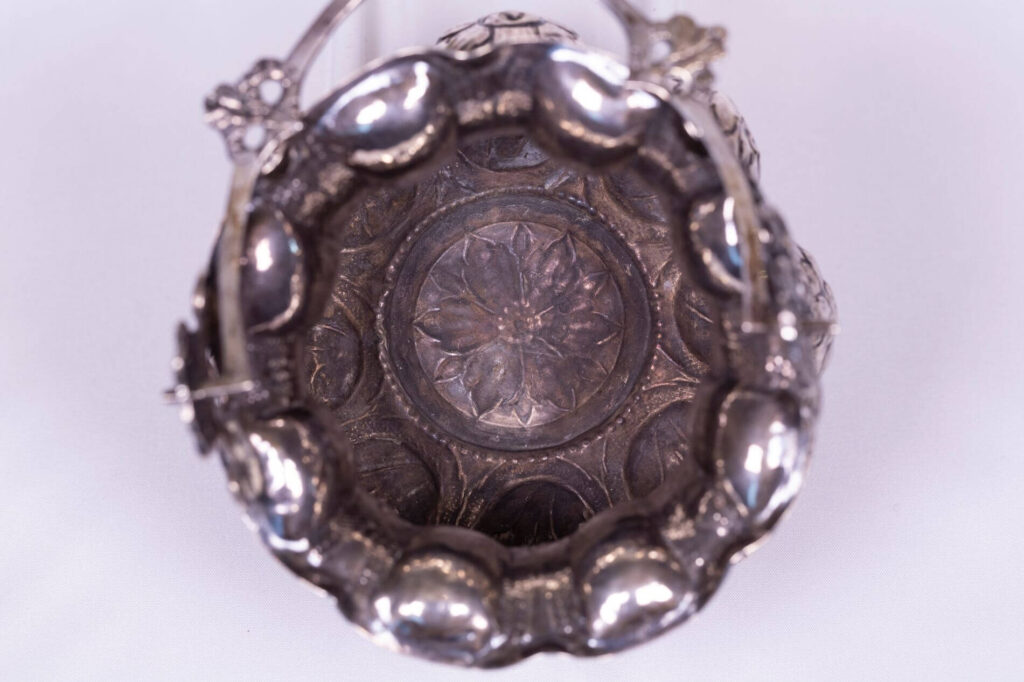

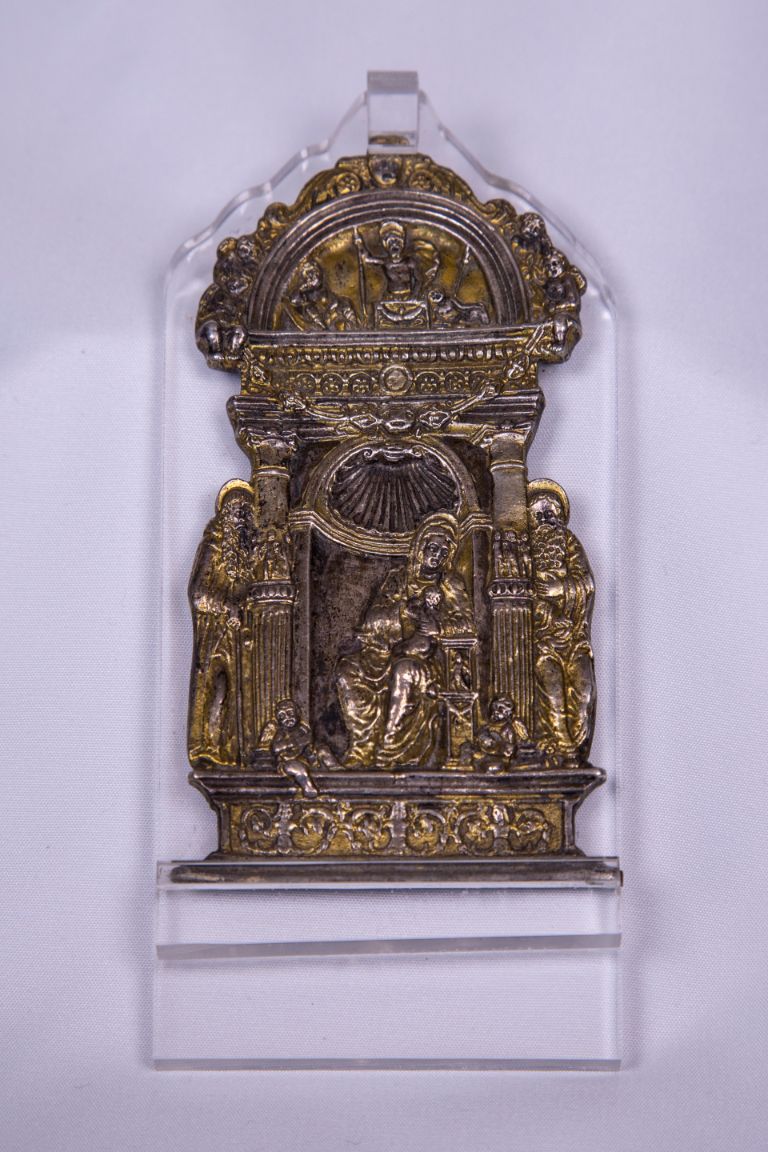

🗓 Beginning of XVI century
📍 Unknown author from North of Italy (Veneto?)
🏆 Gilded bronze Cm 10,5x 6
This is a small relief that is known to exist in different versions, and in many materials, and is called “Pace”.Many times, the subject is a deposition of Christ, but this“Pace”has the Virgin Mary sitting like a Roman materfamilias (a female head of a family or household) in a chair holding the baby Jesus, and surrounded by Saint Rocco, Saint Marco, and musician angels. The Virgin is represented in an apse of an architectural classical building.
On the top, there is a tympanum or lunette with the Risen Jesus, raising from the tomb, and the sleeping soldiers. All the relief is decorated with classical elements quite common in the Renaissance, like mascheroni veneti (Venetian mask), festoni of fruits, and the sirene bicaudal (sirens with two tails).
This bronze relief is gilded with a technique called “mescola” because they used a similar element to glue to attach gold leaves on the bronze. This “Pace” was used as a liturgical object during the celebration of Mass, and people used to kiss this relief instead as the sign of peace. The presence of the Virgin Mary, and of specific saint like Saint Rocco and Saint Marco is a suggestion to us that these were the patron saints of the community where this “Pace”originates from. In this relief one can see the influences of very beginning of the Renaissance: using classical Roman decorations, in the same choice of the architectural structure as a tiny temple, and in the position of the Virgin Mary. Indeed, it is an extremely high quality object, and it was made customized on the request of the church which used to have these saints like patrons. It is a fusion from a mold, probably lost wax, and later carved and refined in detail.
This is a part of a hunting gun probably made in the beginning of XVII century. A “doglock” is a type of lock for firearms that preceded the ‘true’ flintlock in rifles, muskets, and pistols. This type of lock had no internal, half-cock loading position as the later flintlock mechanism contained. To load a firearm with a doglock, the cock of the gun was secured with the external dog, preventing it from moving forward to strike the frizzen and begin the firing sequence. The user could then safely load the musket or pistol. To fire, the cock was moved to the full-cock position, which caused the dog to fall backward and no longer prevent the lock from firing.
This tiny peace of iron is a real sculpture, and it is all decorated with mythological animals, and human faces. It is a particularly important work of art, and the author was a particularly good artist. Even this doglock is only a part of a gun, we can only imagine how amazing could be all this rifle. There is only the toll at the top without a decoration. The two plates that are keeping the flint are engraved with feathers, and head of ducks or something like a wild animal. The main character engraved in the doglock is a horse which is standing on humanoid heads. The style of decoration is still gothic, but it is important to remember that in the work of arts styles stayed the same for many years later. The technique to engrave this doglock is of course the same used to décor armours.
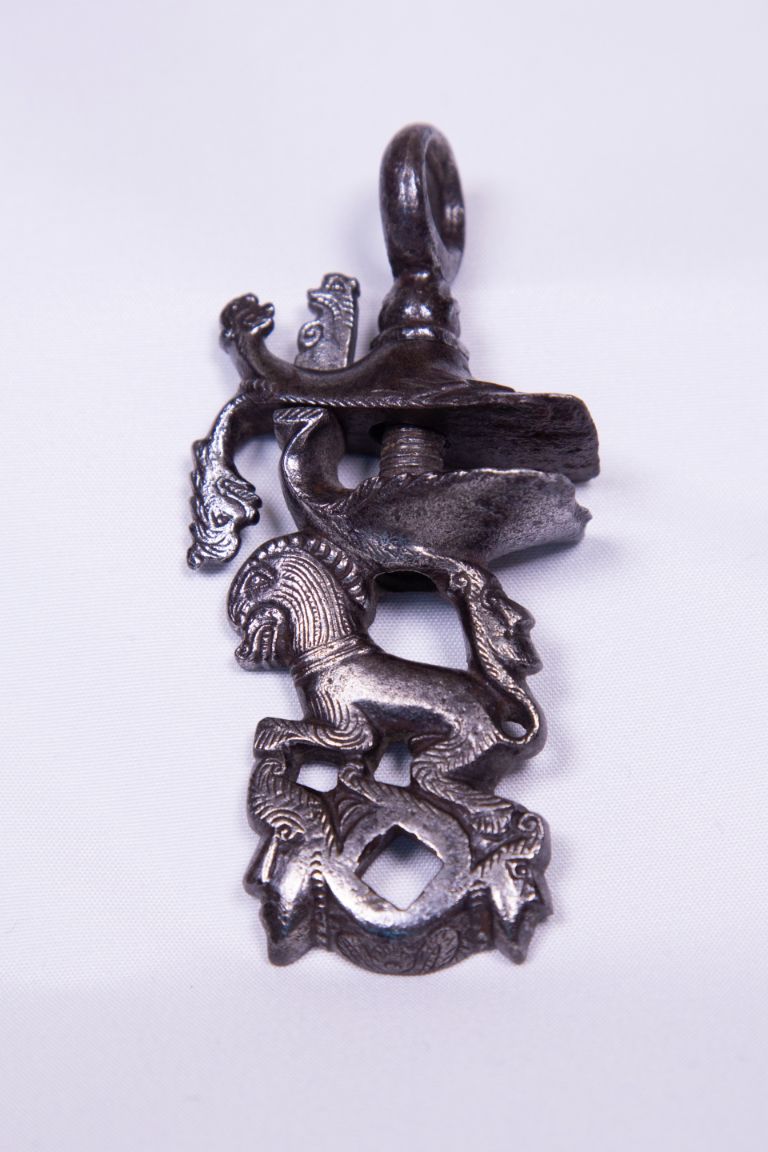

🗓 XVII century
📍 North of Italy – probably Brescia area
🏆 Iron, 9x4cm
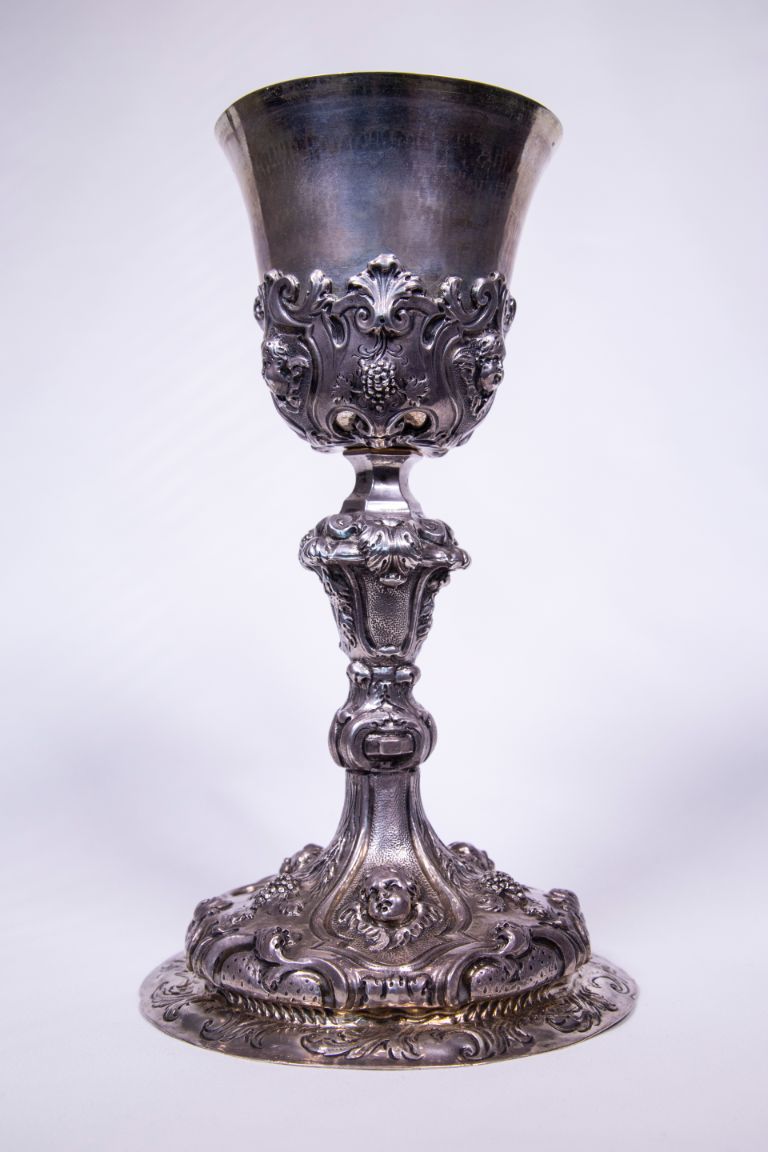

🗓 Brescia, (Republic of Venice), XVIII century
📍 Silversmith [GT]Giovanni Tonoli
🏆 Silver cm 23x13
This is a particularly important chalice, and it was made in the city under the control of Venice. It is a very good example of a liturgical object from the age after the Baroque. The style is still very similar to Baroque: cherubim, the motif with grapes and stalks of wheat, leaves from acanthus tree, and strawberry. The silversmith, who made this chalice, is represented by the silver mark [GT], and his name was Giovanni Tonoli who worked in the shop called “Holy Spirit”. He worked there after 1750, and then this chalice was made in the second part of XVIII century.
One can see how great Tonoli was doing embossment of the silver foil. The chalice has a foot welded to the body of it designed like an architectural element, and at the top a tool has joined the cup to the main part. The embossment is made, as great silversmith did, keeping soft the silver using warm pitch. The cup is gilded only inside, and for a tiny crown outside (because the priest drank attaching his lips) with an old technique adding real gold leaves to the mercury, and to warm up in an oven. During this process, the gold attached to the silver, and mercury evaporated as dangerous gas. One can say that this chalice is not any normal produced object but a masterpiece created by a famous silversmith.
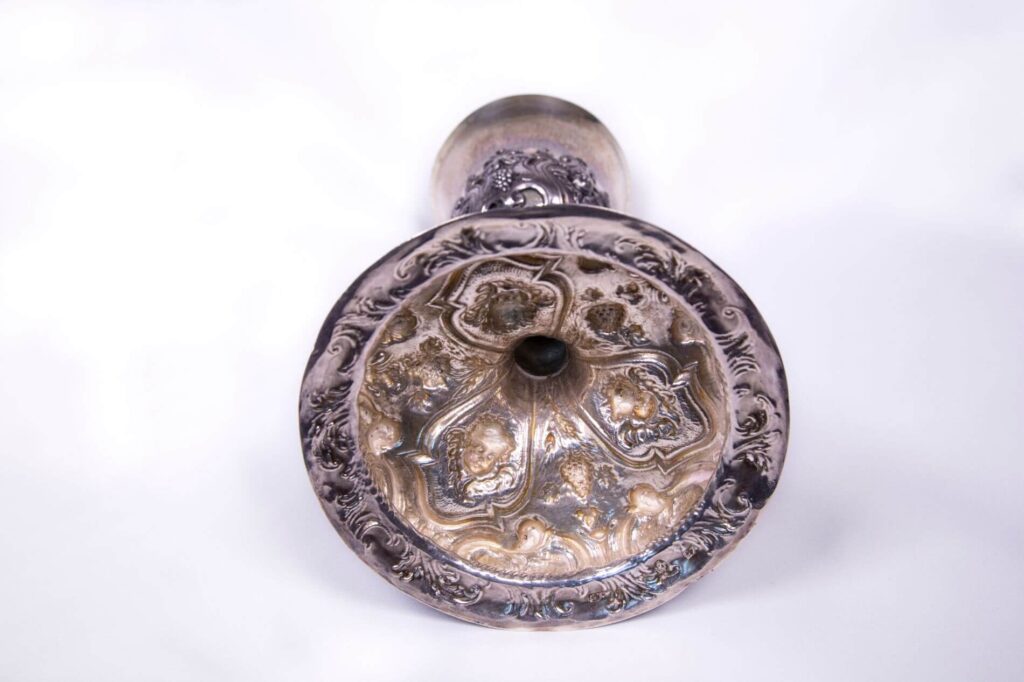

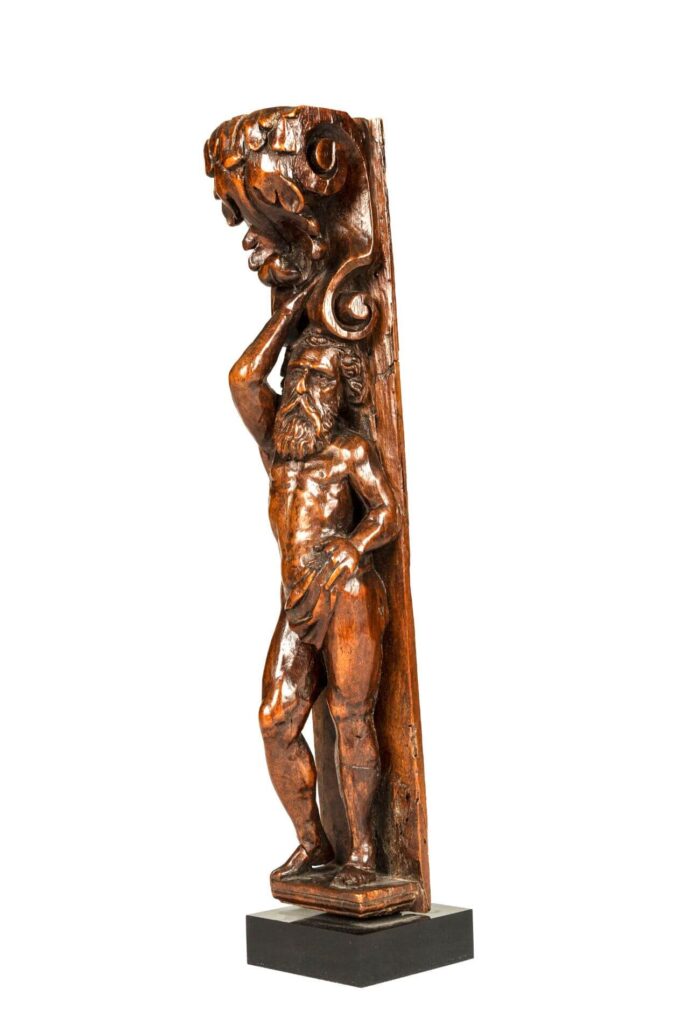

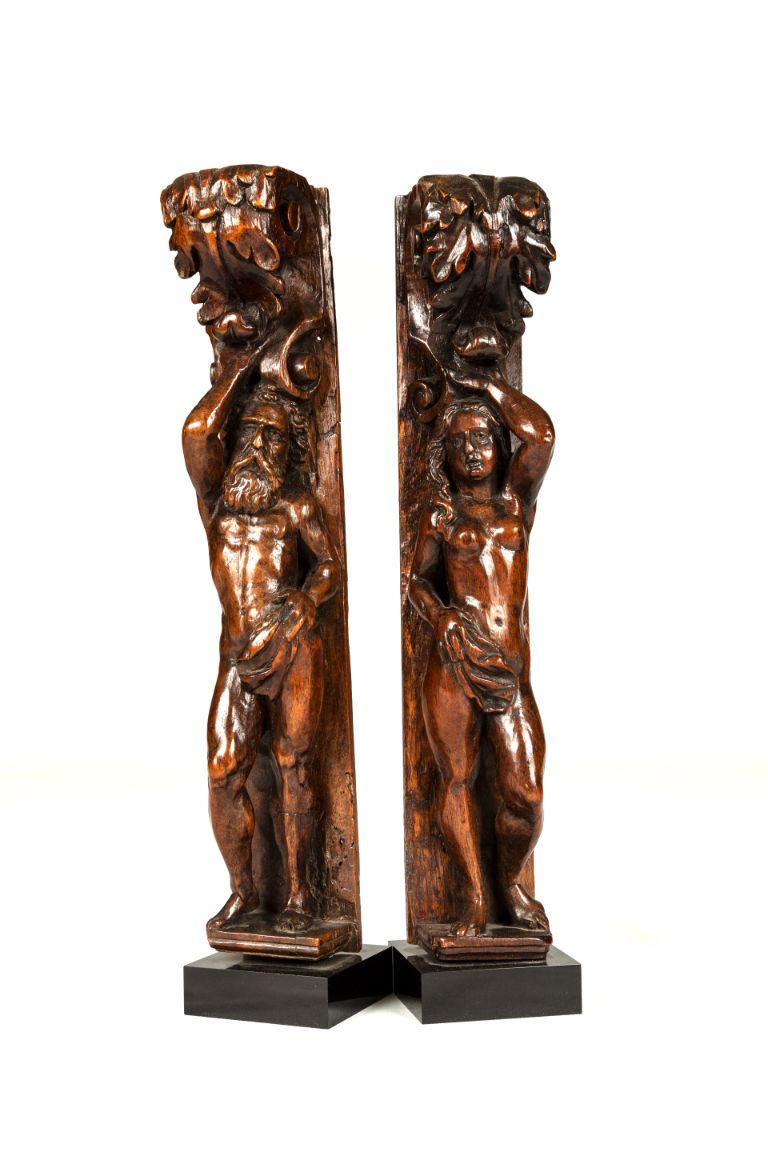

🗓 XVI century
📍 North of Italy, probably Bergamo
🏆 Walnut carved 30x 6cm
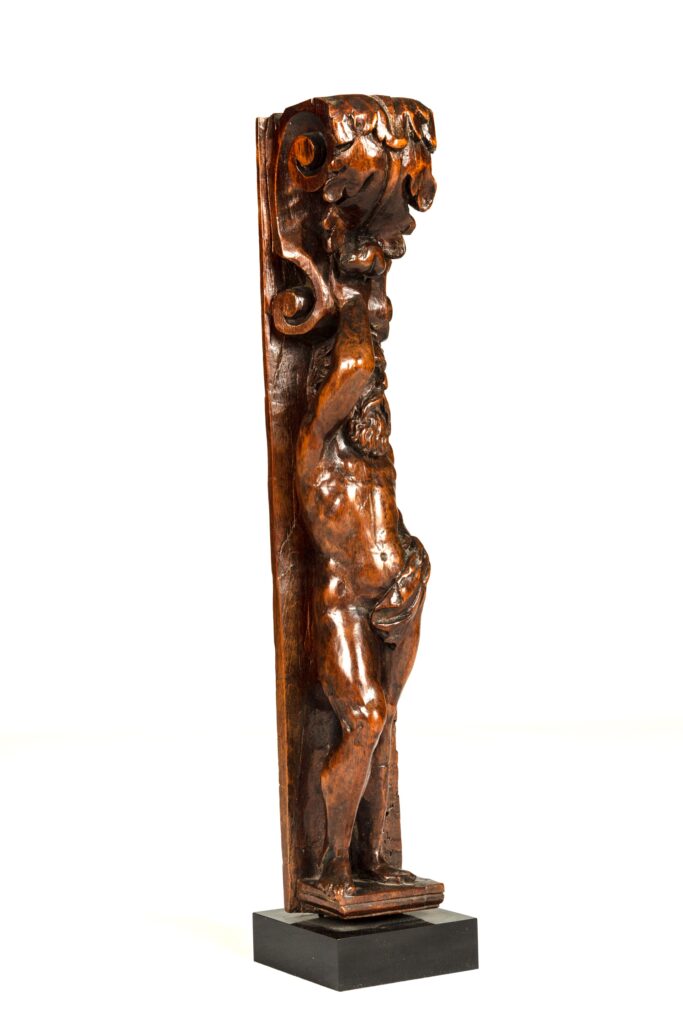

These statues, or it is better to call them caryatids (sculpted figures serving as an architectural support in place of column or pillar), were part of a walnut furniture of a sacristy. The same word “sacristy” means sacred placed, and indeed in this furniture all the liturgical objects called “sacred vases”, and vestments used for sacred rites were stored. These important objects and vestments needed to be contained in furniture that was very elegant, and made in the best wood possible, usually walnut.
To highlight the importance of a sacristy, and of these furniture types, many were decorated with caryatids, sculptures or inlaid with different kinds of woods created like a painting. These statues represent Adam and Eve, both nudes and covered with two leaves. The faces of these characters are defined in detail: a long beard and mustache, and a not young face for Adam; long hair, and a simple face with deep eyes, and a long nose for Eve.
The sculptor was not a normal artisan, but someone who was able to see, or to study the classical sculpture in the Renaissance artistic styling of Michelangelo. Indeed, one of the truly clear details for each body is the presence of muscles, on the legs, and on the body. Both of statues was carved in the XVI century, but likely at the end of the century because they are following the style of the first Renaissance, and in the art works this style arrived later but stayed longer.
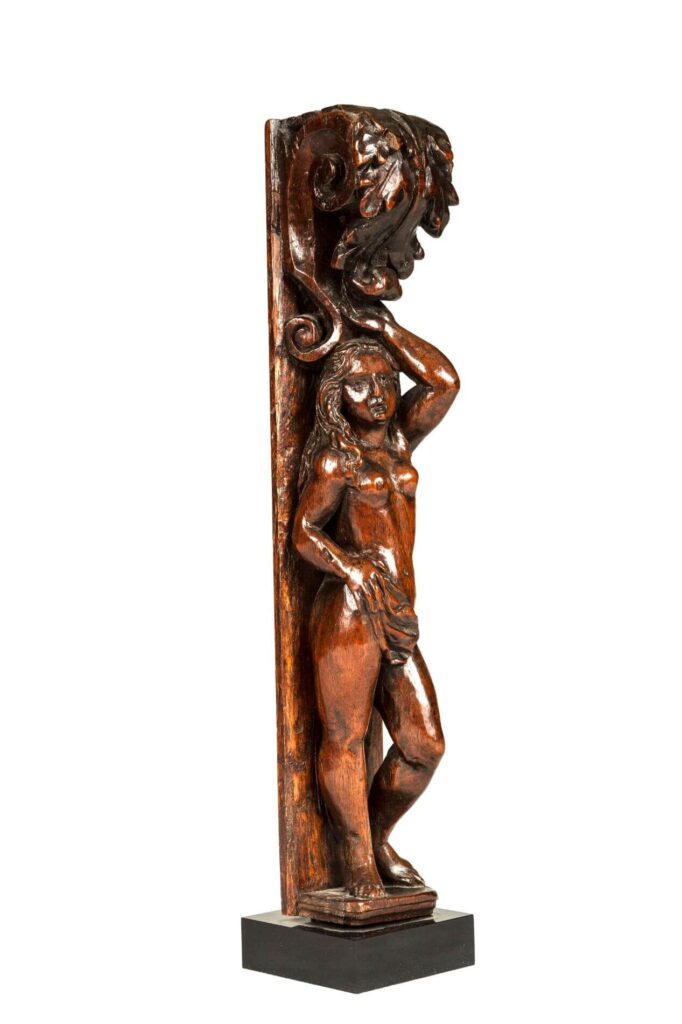

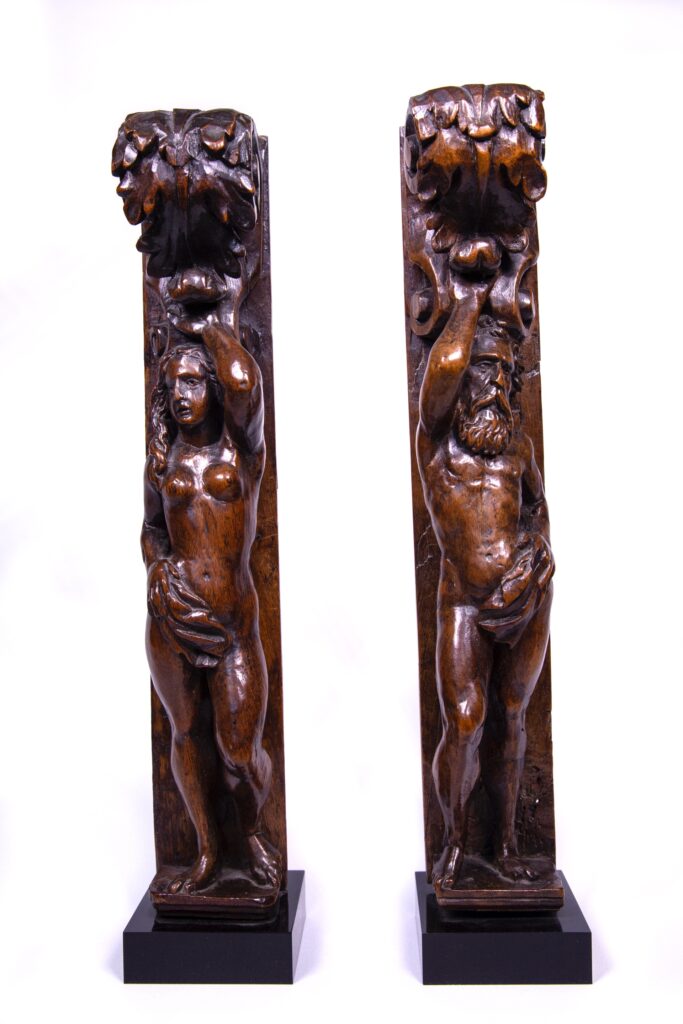

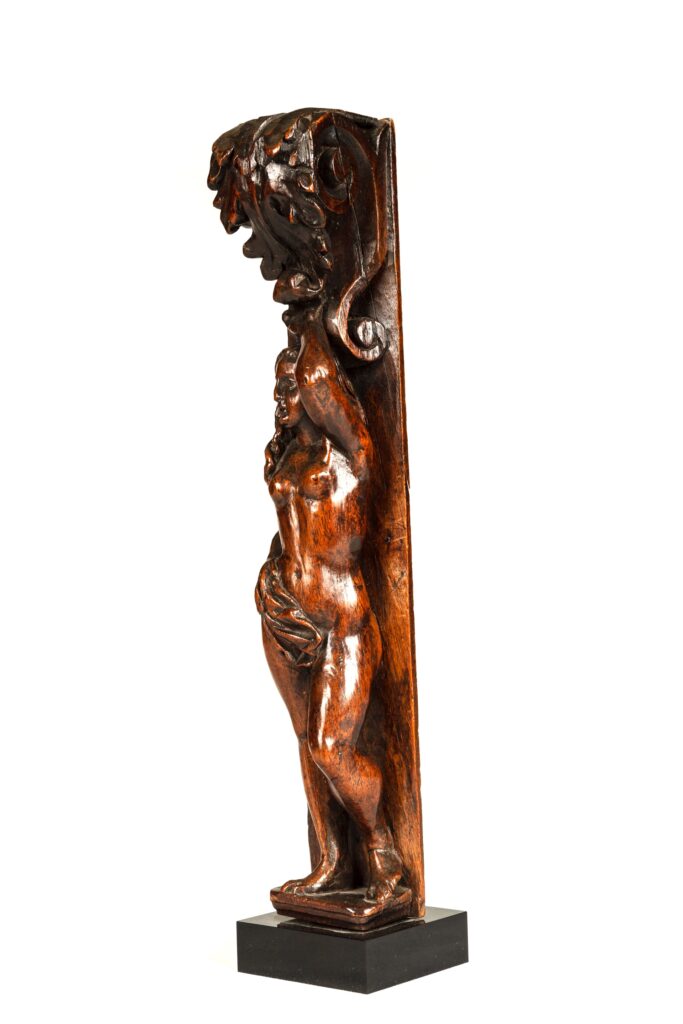

This couple of objects have very interesting story, and even though one is viewing a replica, it is interesting to talk about it. The artist was a very interesting person, sculptor, artist, coinmaker and actor. Amerigo Tot (1909-1984), Hungarian background, was a member of the Bauhaus a German group of artists, but he lived many years in Italy and in Rome where he died. He enjoyed being an actor in movies, and in the Godfather II, he was portrayed as a bodyguard for Al Pacino’s character while in Cuba.
This interesting man was a wonderful designer of coins for Vatican City, and he made many sculptures, and between all of his productions he created the original Hammer and Trowelfor the Saint Pope Paul VI to use for the opening of the Holy Door. All the employee of St. Peter Basilica, and Fabbrica di San Pietro wanted to offer to the great Pope born in Brescia these tools. The versatile artist wanted to take the real shape of the hands of St. Paul VI to personalize the tools, and indeed we see the imprint of his hands in the handle. The originals are in the Treasury Museum of St. Peter Basilica, and I prepared in 2014 an exhibition for the beatification of Pope Paul VI incorporating the original.
The theme of the hammer is the Passion, and one can see in the head of the hammer nails, like in the cross, in the middle there are four medallions with the symbols of the Evangelist, and these coins are solid gold on the originals. On the trowel, we can see a large coin on the spatula with two pilgrims recalling the pilgrimage for the Holy Year 1975. In both handles, one can notice the shape of the hands of the Pope Paul VI, and both objects end with a gold coin with the crest of this pope.
In this replica, the material is bronze, but in the originals both are made in silver, with the addition of many gold coins. Again, on the body of both, one can see the silver mark of Amerigo Tot [Tot] and the sentence in Latin language recalling the Jubilee.
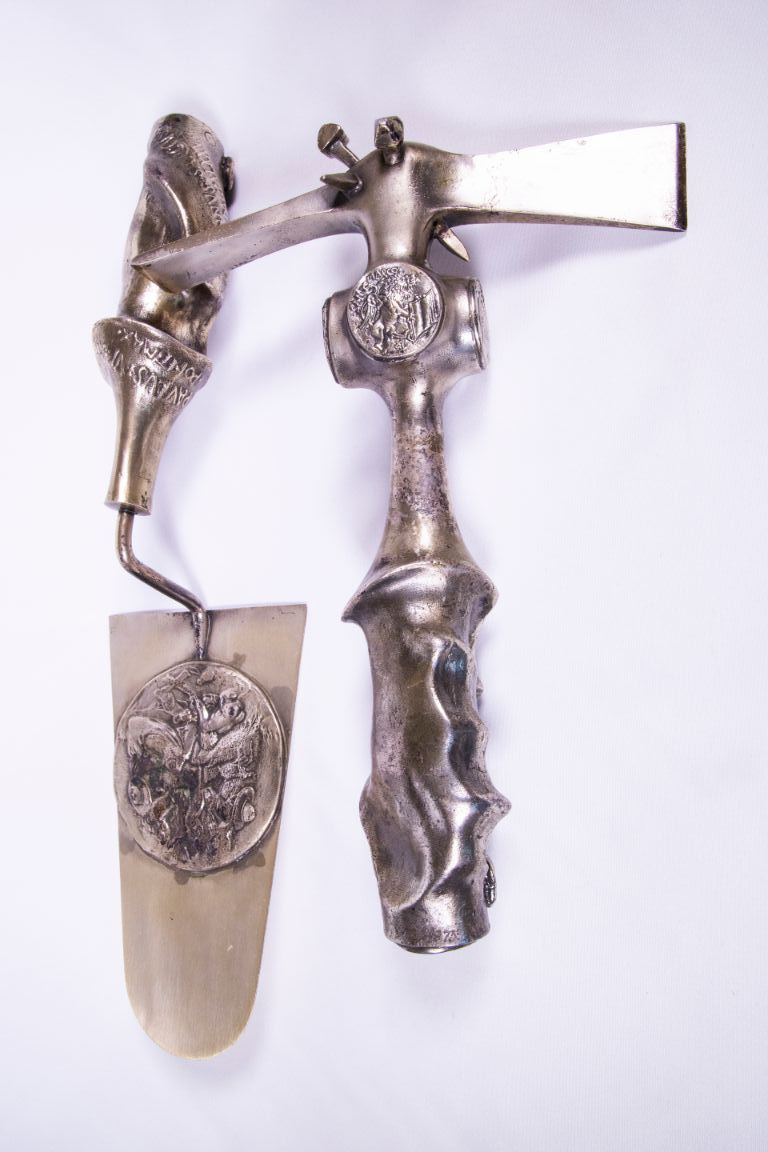

🏆 20 x 13cm trowel
🏆 30 x 20cm hammer
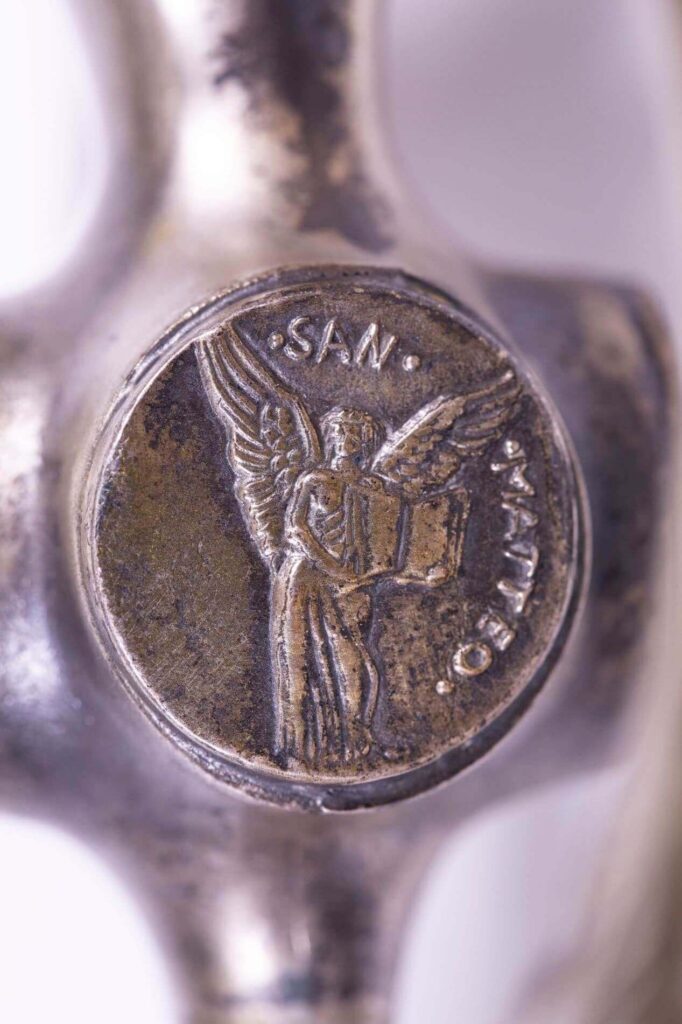

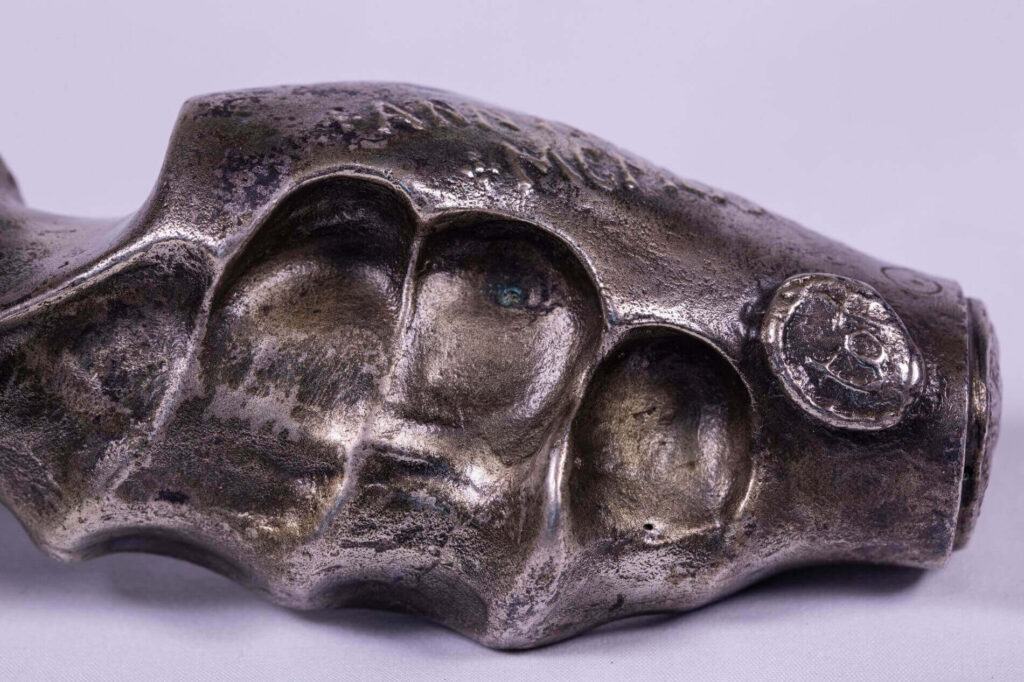

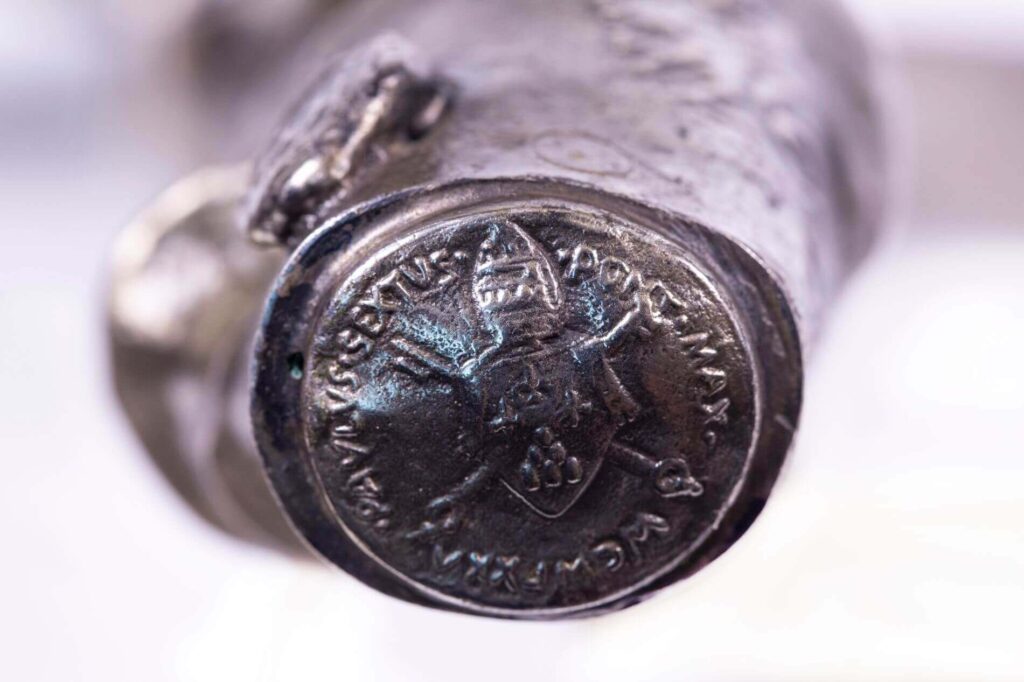


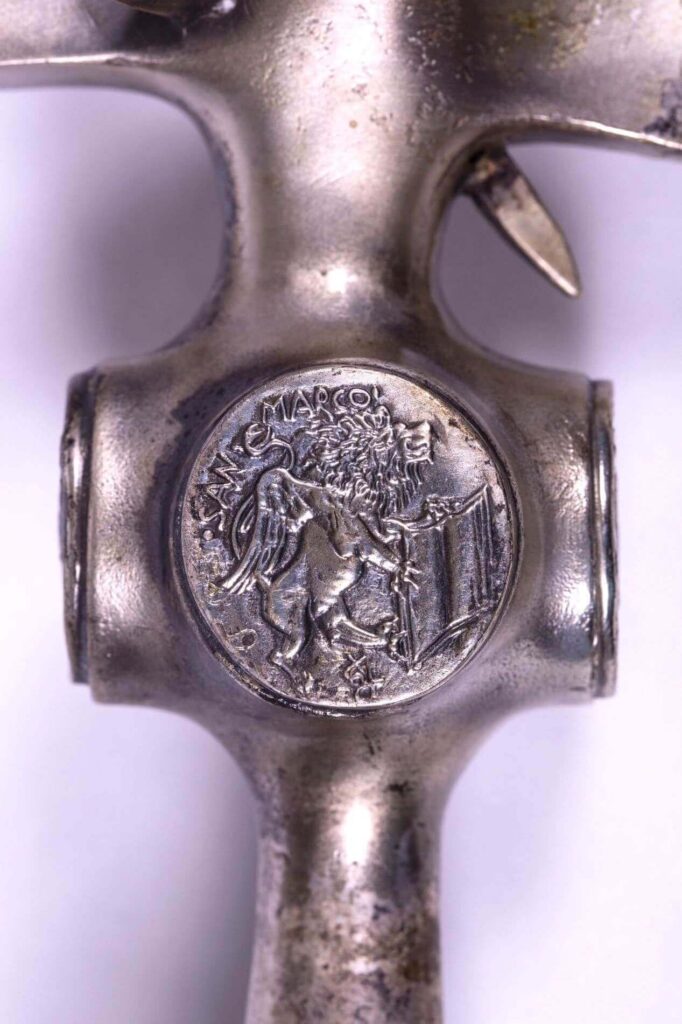

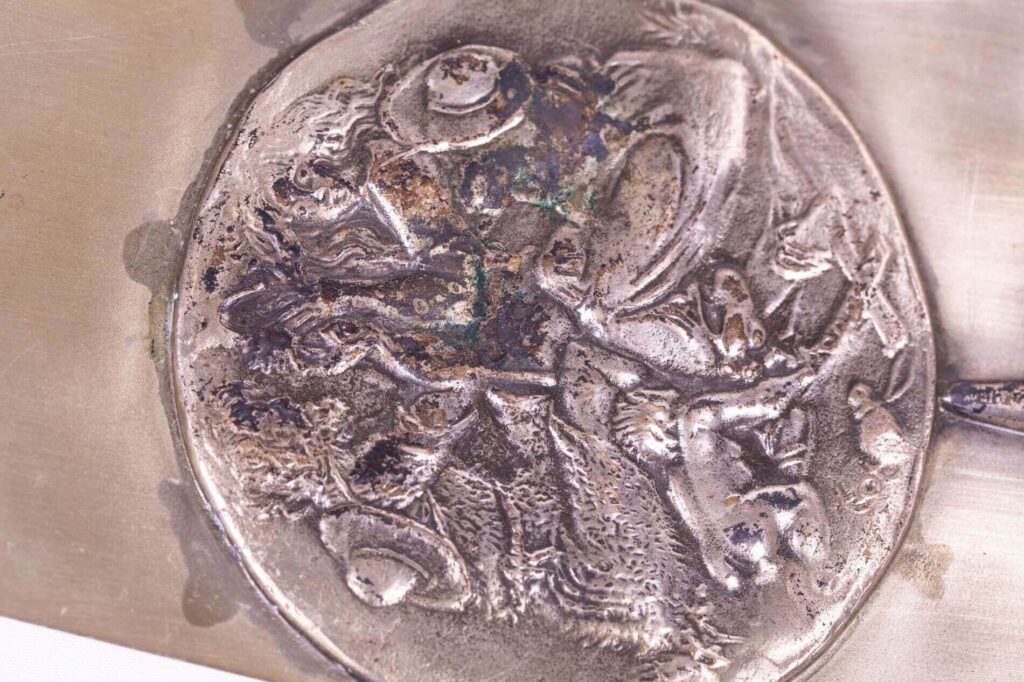




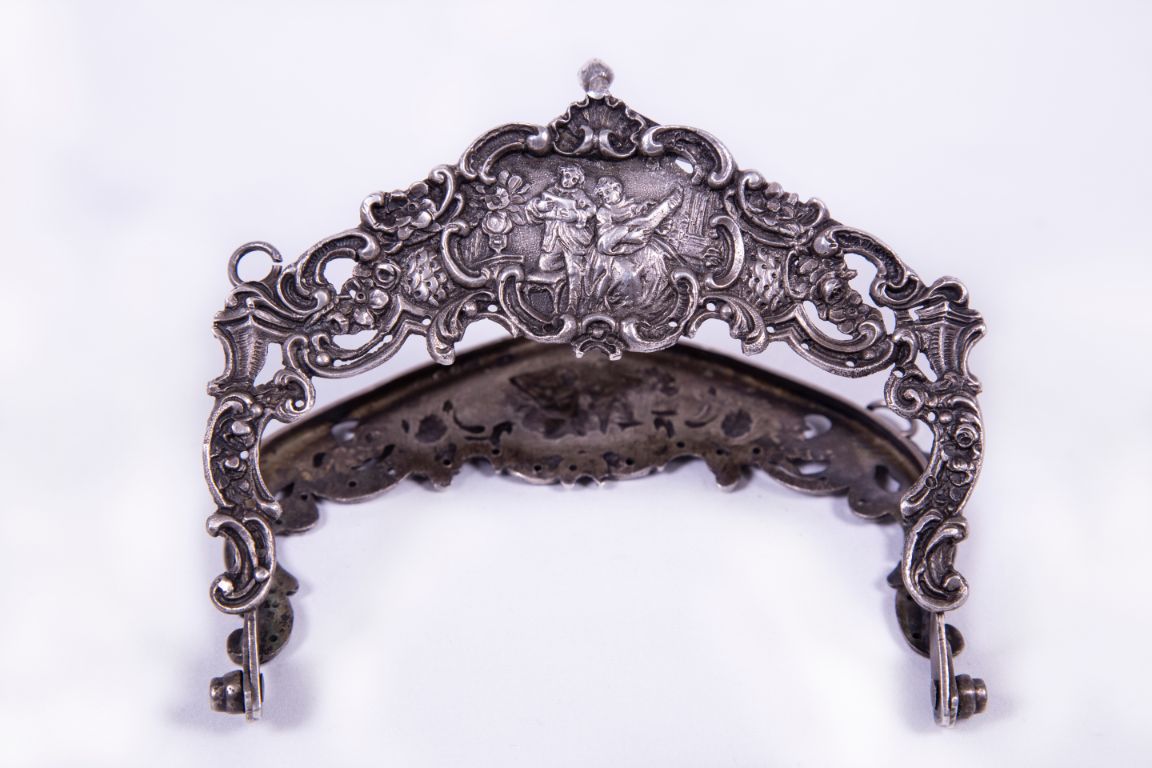

🗓 End of XIX century, beginning of XX
📍 Italy
🏆 Silver, 12 x 5cm
This is the top part of an elegant purse, which would have been used to attend the opera. Indeed, at the top of the clutch, one can see a male singer, and a female musician in an elegant room. Around the bottom of the border of this clutch, there are many tiny holes, where the body of the purse would have been attached. Usually, this kind of high-class purse was made both with fabric intertwined with silver assembling many tiny silver chains.
This purse part is quite simple as the artisan put together the same two designed pieces, from the same mold. The design is influenced by the Baroque age but is considered an industrial/artisanal work as the artist refinished the product from the mold, but no more than cleaning. This piece is important not for the work of art, or the technique used to make it, but to highlight the kind of high society accessory used in Italy to attend a concert.
This processional cross was used during liturgical processions, and during the Mass. Indeed, in the past, many times the Mass was celebrated only in the main church called “pieve”, and people from other villages or town gathered there carrying this kind of processional cross which for them was like the logo of their community.
Usually every cross was customised by the silversmith with a representation of the patron saint, or with the titular of the same community’s church. These crosses were called “polylobate” because each arm ended with a space where the artist put a relief. In the front, there is Jesus’ body, on the horizontal arm the Virgin Mary, and St. John called “dolenti” because they stay at the feet of the cross until Jesus died, and on the top God Creator, and Mary Magdalene at the end.
On our cross, in the front someone moved the symbols of the Evangelist called “Tetramorph”, and indeed, on the reverse on the top an Eagle for St. John, and Angel at the bottom for St. Matthew, and the Leo, and the Bull for St. March and St. Luke. In the back of the cross, we can see the Virgin and the child Jesus in the middle (it means that the Virgin Mary was the titular of the church for which this processional cross was created for).
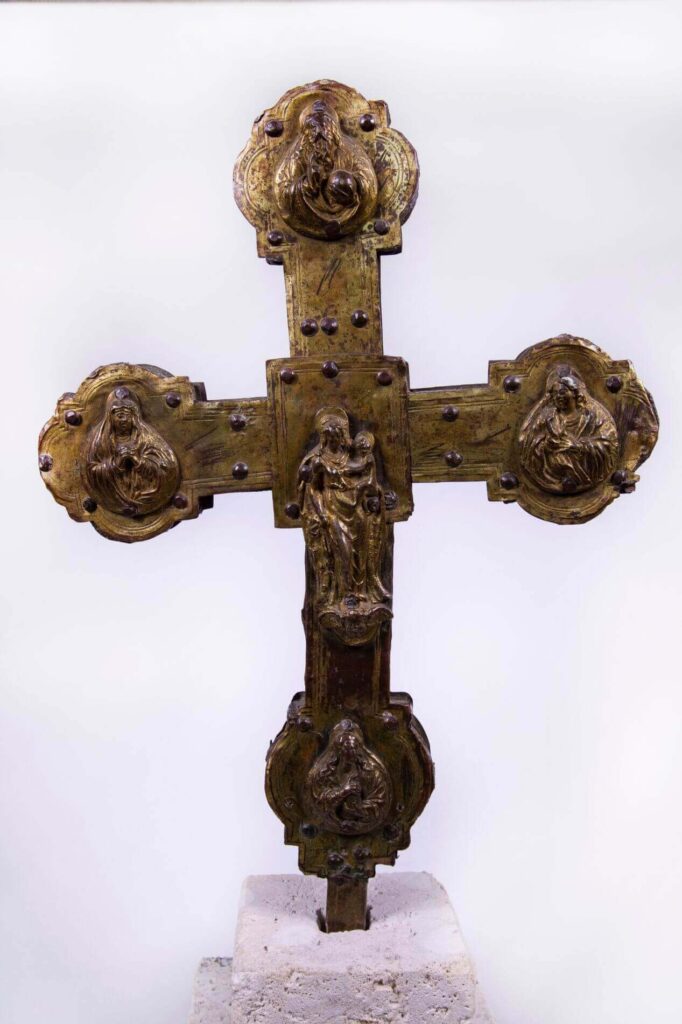

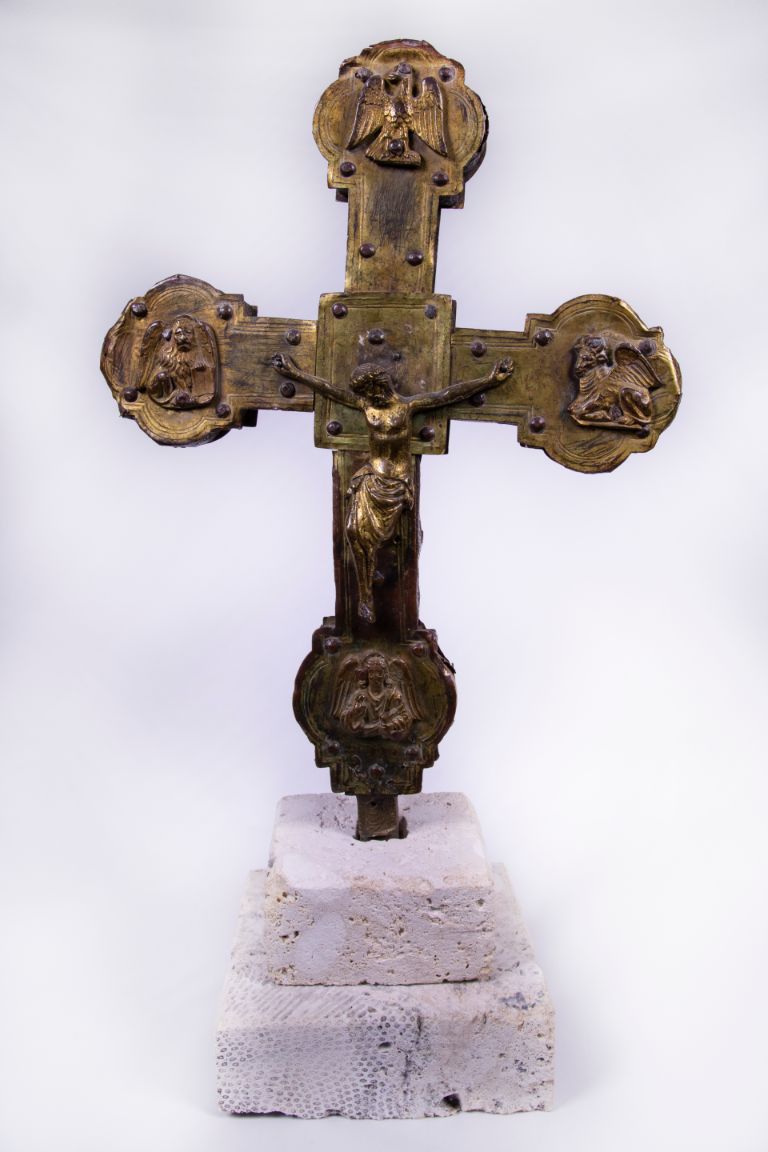

🗓 Beginning of XVI century
📍 North of Italy
🏆 Wood, copper gilded cm 36x26
The cross is made in wood, and covered with a foil of gilded copper, and on the profile the foil is decorated with an element consisting of plant motifs unfolding in the form of volute.
The Christ on the cross is not rigid, but shows a movement of Gothic influence, and the relief in the back with Virgin Mary, St. John, the Magdalene, and the Creator are with the same style. The Christ is a fusion of copper gilded, and the other characters were carved in a foil of copper and gilded too. The Virgin Mary is a fusion too, like the symbols of the Evangelist, and their style seems not so Gothic.
This cross probably was restored in the end of of the XVI century, and at that time someone changed a few elements on it. The characters on the reverse of the cross, Jesus Christ and the foil on the cross is from the beginning of XVI century. However, Virgin Mary, and the tetra morph of the Evangelist are from another cross still from the end of XVI century.
In questa parte della nostra esibizione, ci sono ricami e tessuti preziosi che vengono dalla mia collezione e che sono inerenti al culto divino. Per l’esattezza abbiamo tre veli da calice, un set con velo e borsa, una pianeta romana rosa e una pianeta con ricamo a giardino. Il termine “giardino” fa riferimento alla tipologia di ricami, che solitamente e’ simmetrica, e con disegni floreali o di frutta.
La pianeta con la stola, il manipolo(piccolo stola da mettere sul braccio, la borsa(posta sopra il calice con dentro la piccola tovaglietta su cui appoggiare il calice) e il velo( come dice la parola, copriva “velava” il calice dalla vista del popolo) erano i pezzi che componevano il set per la celebrazione della Santa Messa prima del Concilio Vaticano II del 1965.
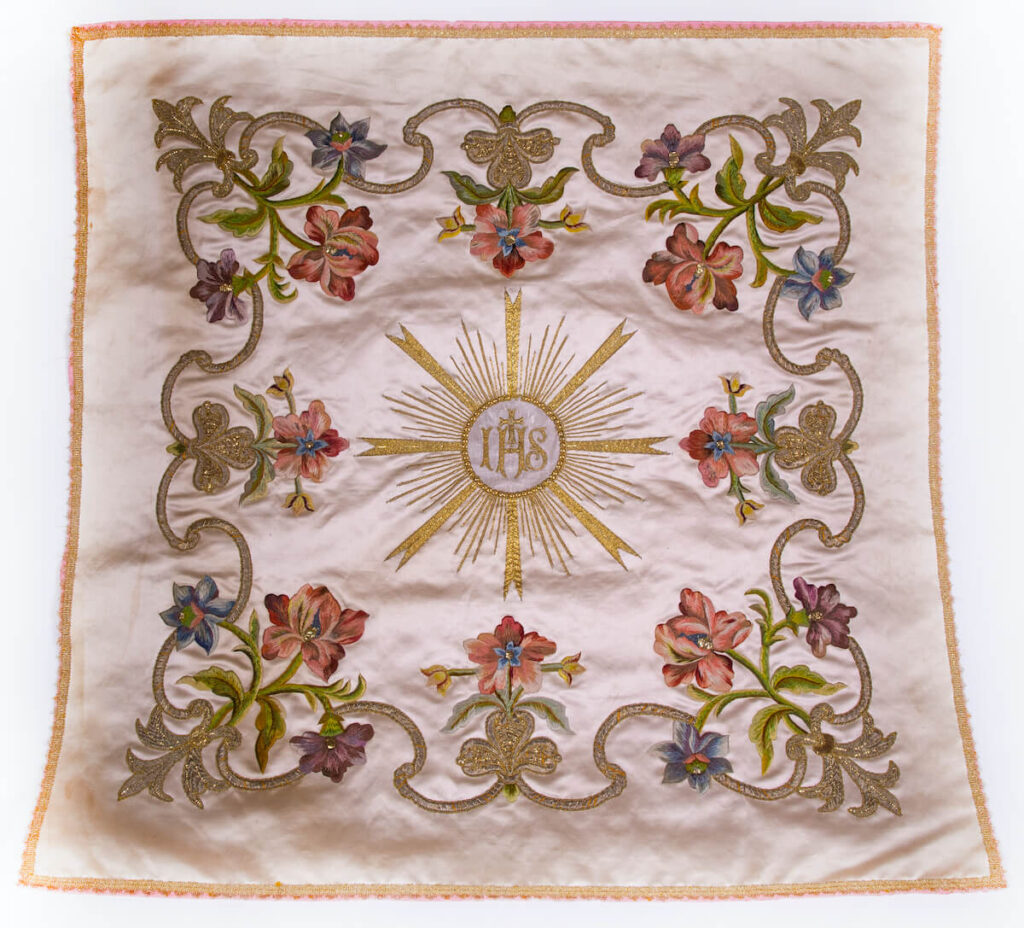


Questo velo e’ quell che rimane di un paramento della fine 1800, inizi del 1900. Il ricamo e’ fatto su raso di seta, e usando filo d’oro. La parte centrale rappresenta il Santissimo Sacramento come un sole raggiante. Interessante l’uso di cartoncino pressato sotto i ricami ad oro che sembrano nastri da cui si diramano fiori, e foglie in filo di seta. Lo stato di conservazione e’ perfetto
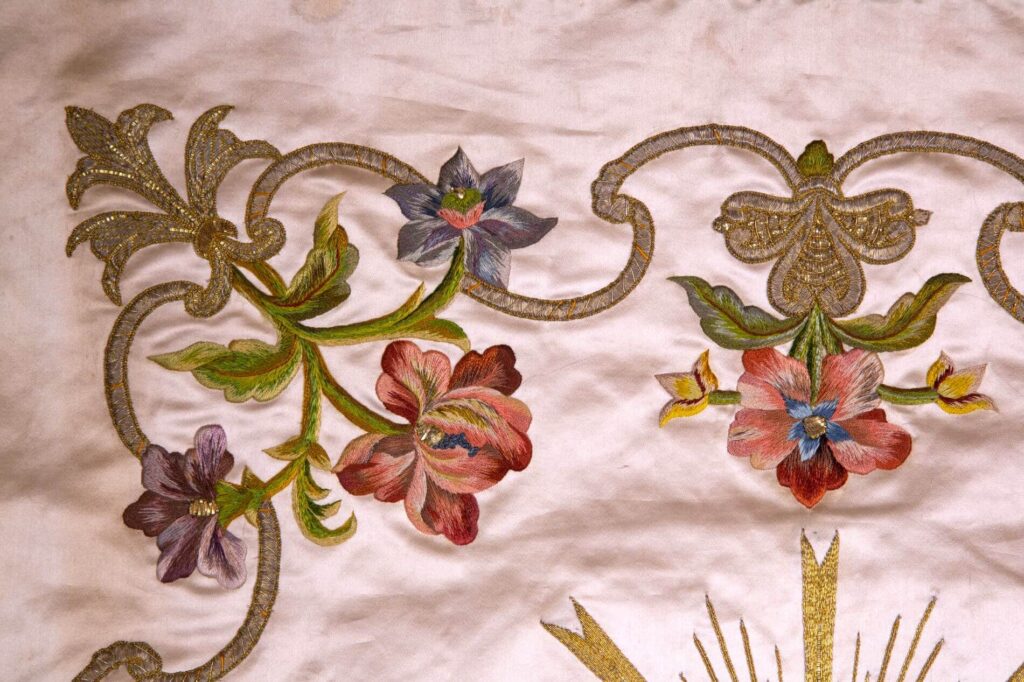

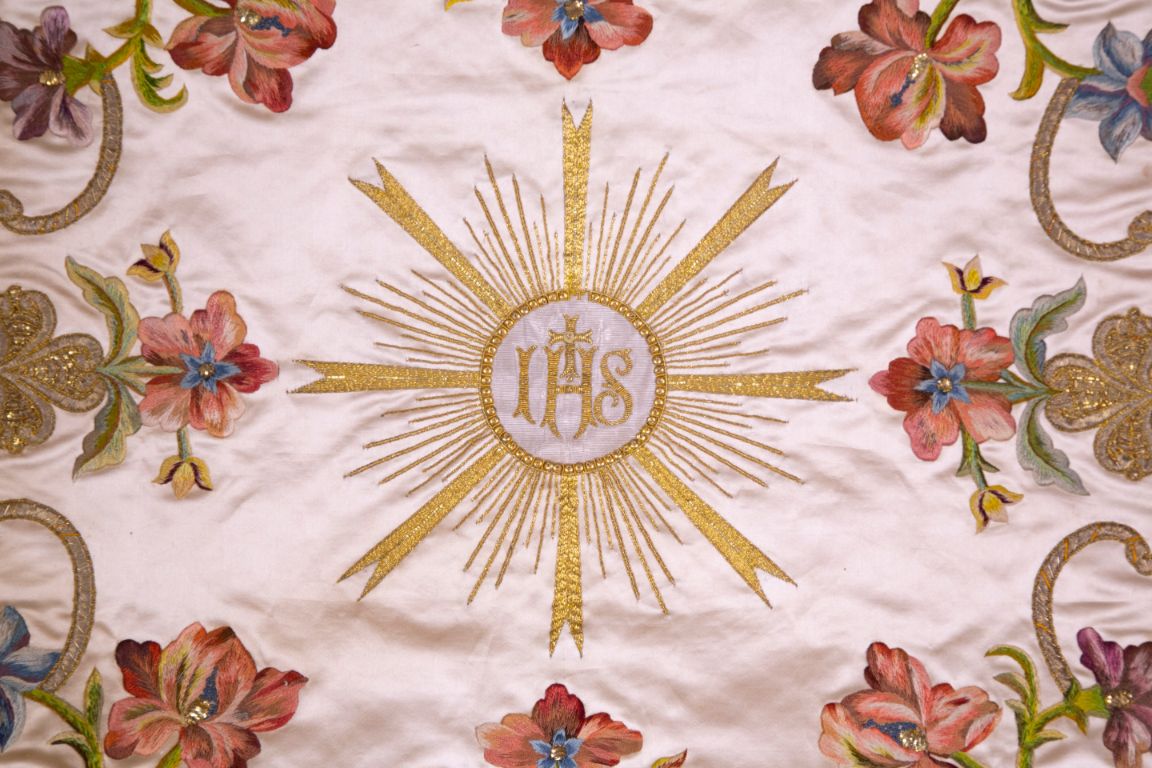

🗓 Raso di seta, ricami oro e seta.
📍Italia
🏆Cm 56x56



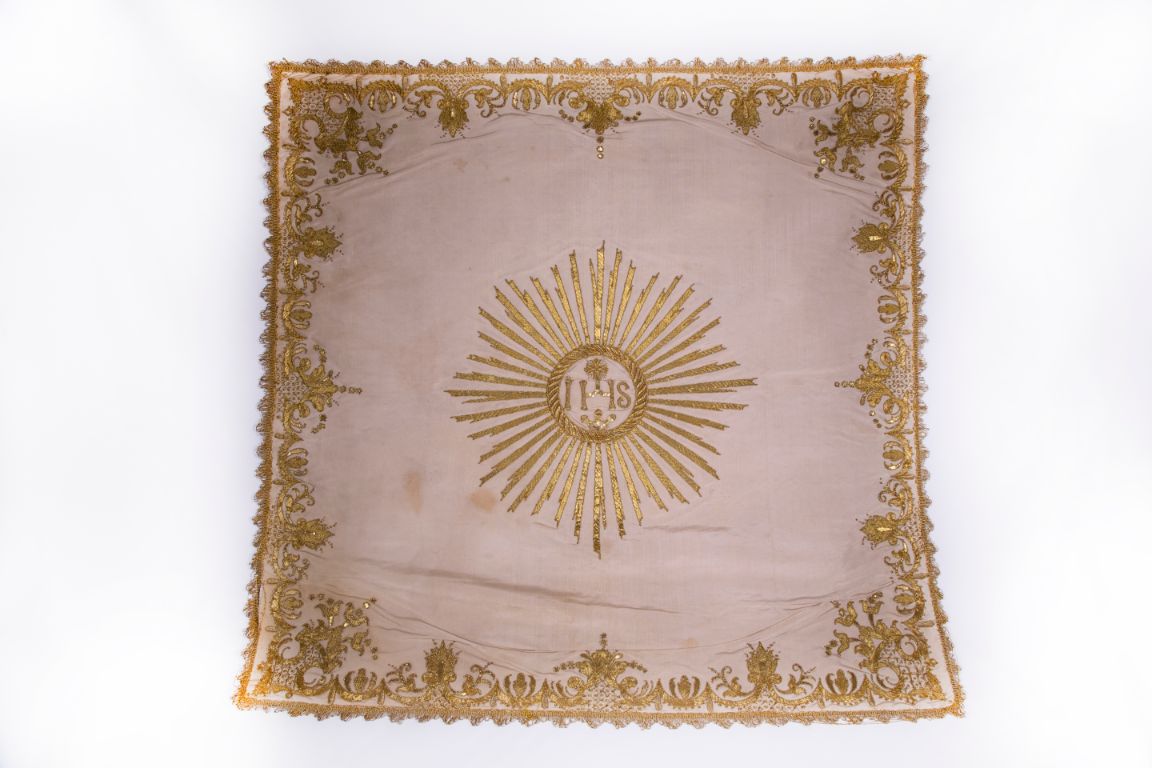

📍 Italia Centrale, forse Roma, inizi XIX secolo
🏆 Cm 64x64
Italia Centrale, forse Roma, inizi XIX secolo
Questo velo di calice e’ quello che rimane di un parato realizzato in oro zecchino e seta, molto prezioso, nel periodo chiamato stilisticamente “impero” ovvero tra la fine del 1700, e gli inizi del 1800. Il supporto del ricamo e’ una seta finissima, e si puo’ vedere come il filo di oro zecchino sia stato steso con punto pieno. Interesante la frangia, anch’essa in oro e filata. Il motivo del ricamo e’ sempre di tipo vegetale, con al centro il Santissimo Sacramento come sole raggiante.
Stato di conservazione buono, tessuto molto fragile con alcuni aloni.
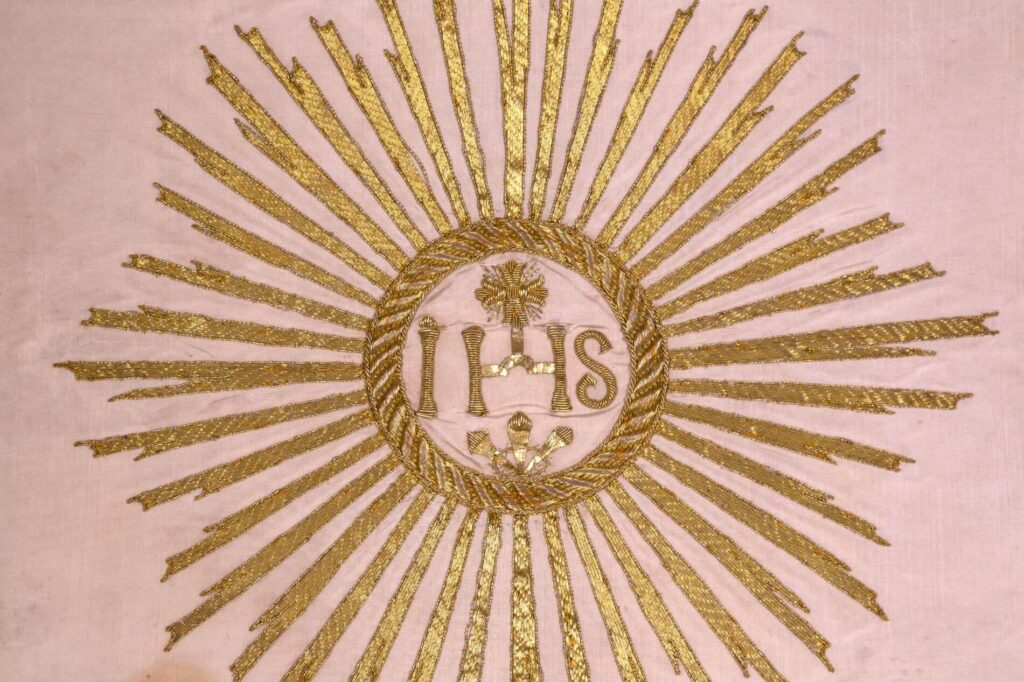

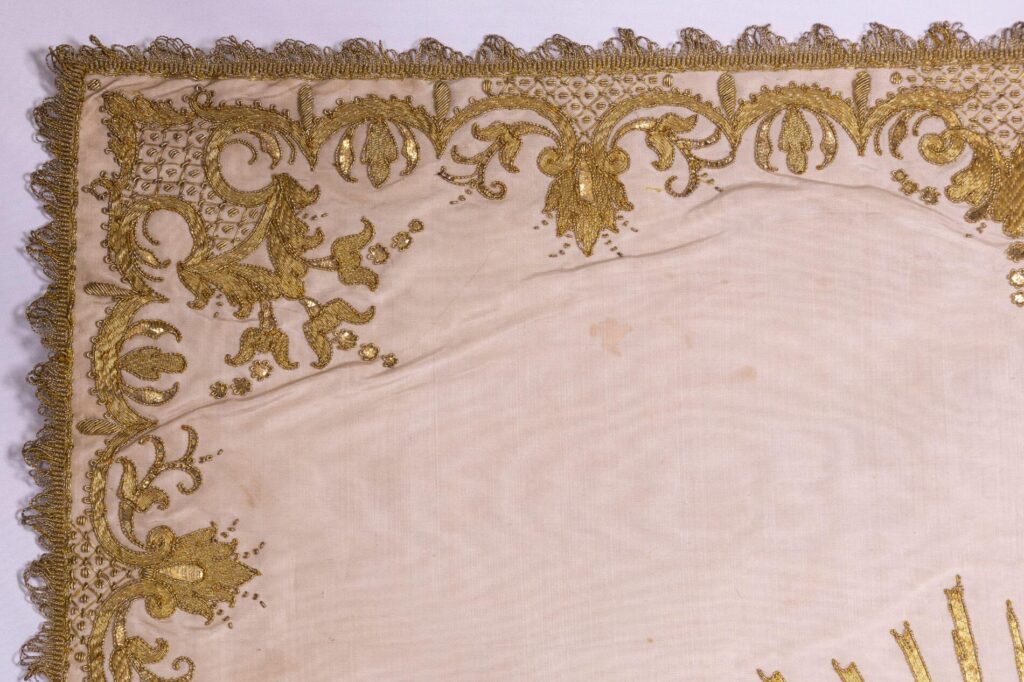

Questo velo di calice e’ quell che rimane di un parato del 1700, probabilmente dalla Toscana. Si possono notare numerosi rattoppi, sulla seta diventata ormai fragilissima. Si possono notare chiaramente i fiori ricamati con filo di seta colorata, e il filato d’oro, che pero’ in alcuni punti e’ ossidato. Il ricamo centrale, con il tema del sole raggiante e’ integro nella parte esterna, ma totalmente perso in quella interna. Lo stato di conservazione e’ precario.
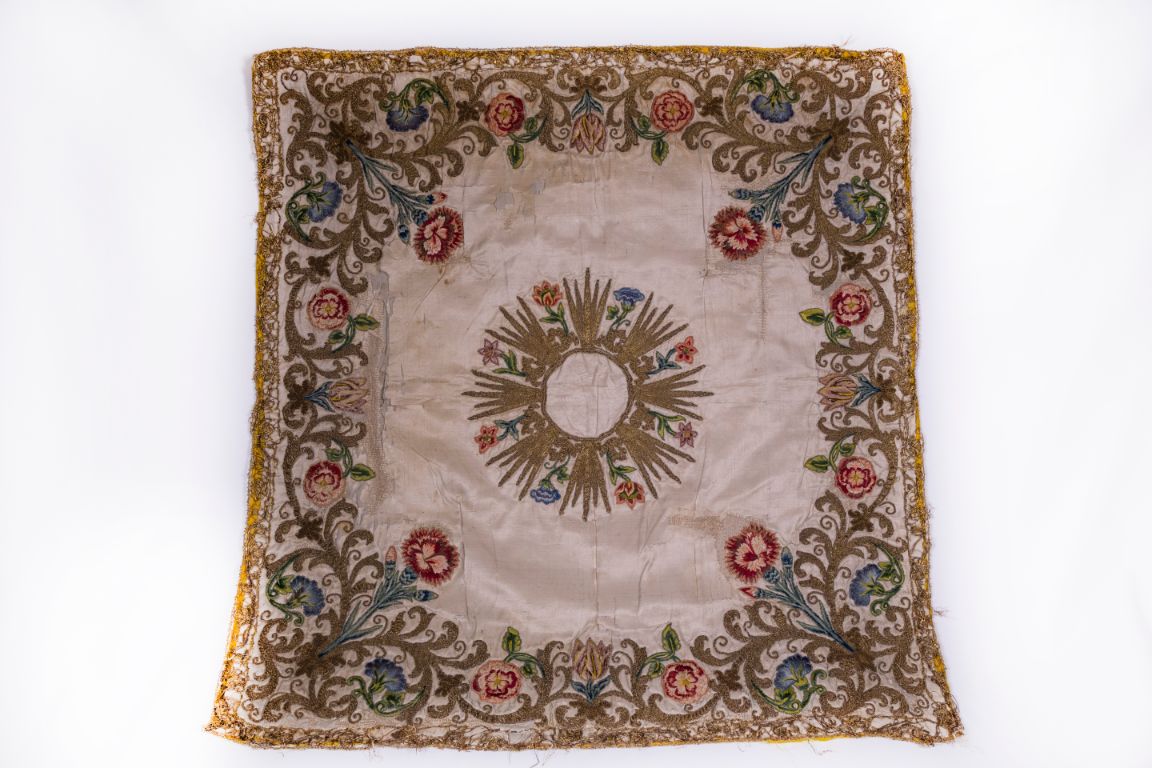

🗓 XVIII secolo
📍 Toscana
🏆 Cm 59x59
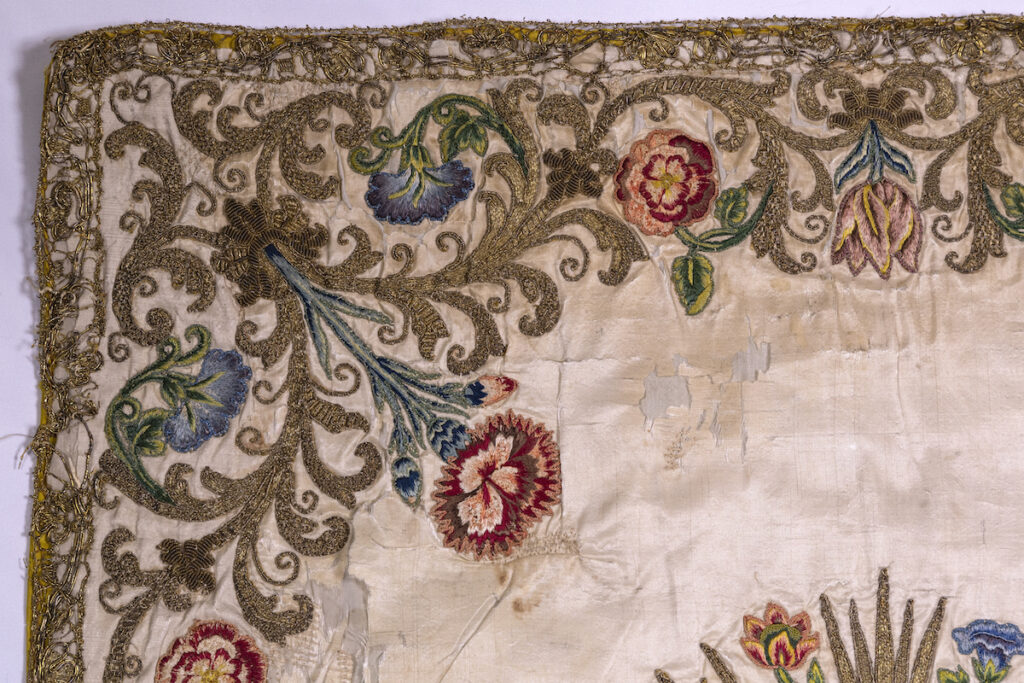

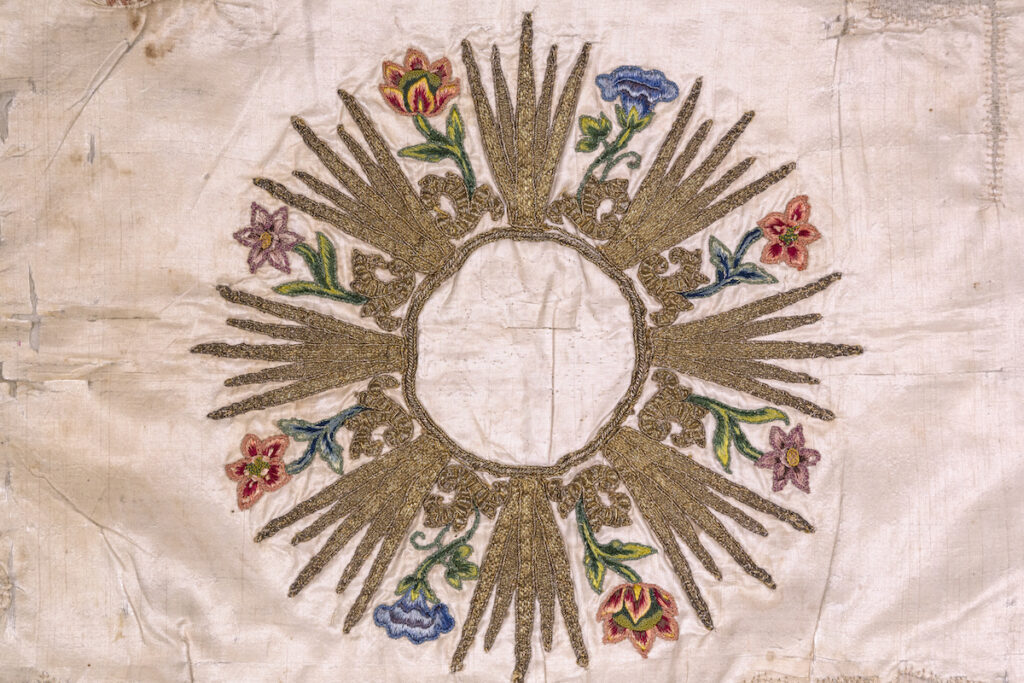

Questo paramento rosa e’ degli inizi del 1800 e utilizza un raso di seta probabilmente venuto da una manifattura genovese, o veneziana. Il tessuto lavorato con filo d’oro e sete policrome e’ contornato da una stupenda bordatura in oro zecchino. Il paramento sembra nuovo da tanto lo stato di conservazione e’ stupendo.
I motivi decorative possono richiamare molto lo stile orientale di quel periodo, infatti questi tessuti molto alla moda tra fine 1700 e fino alla fine del 1800 erano utilizzati anche per tapezzare importani stanze in palazzi nobiliary, ed avevano motivi esotici orientali.
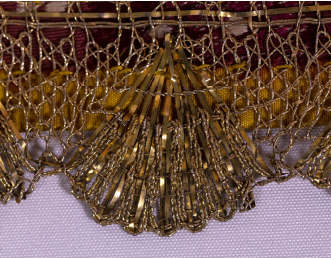

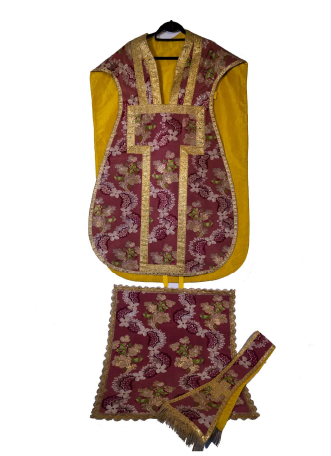

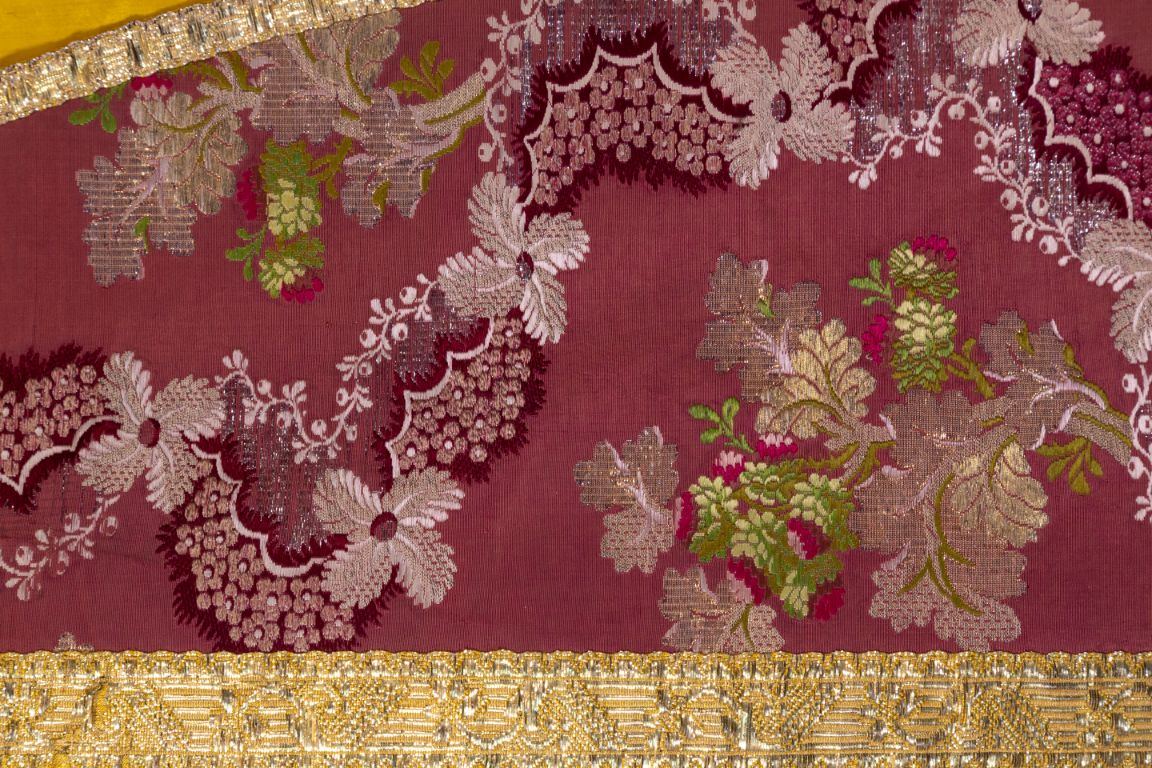

🗓 Piemonte XIX secolo
📍 Stola, Velo, Pianeta
🏆 cm 110x70
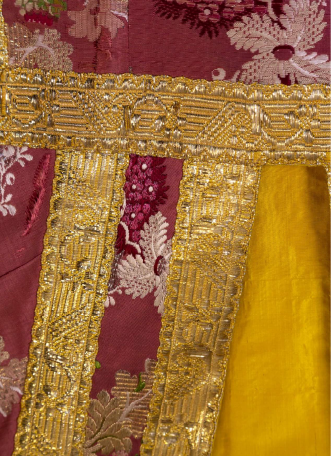

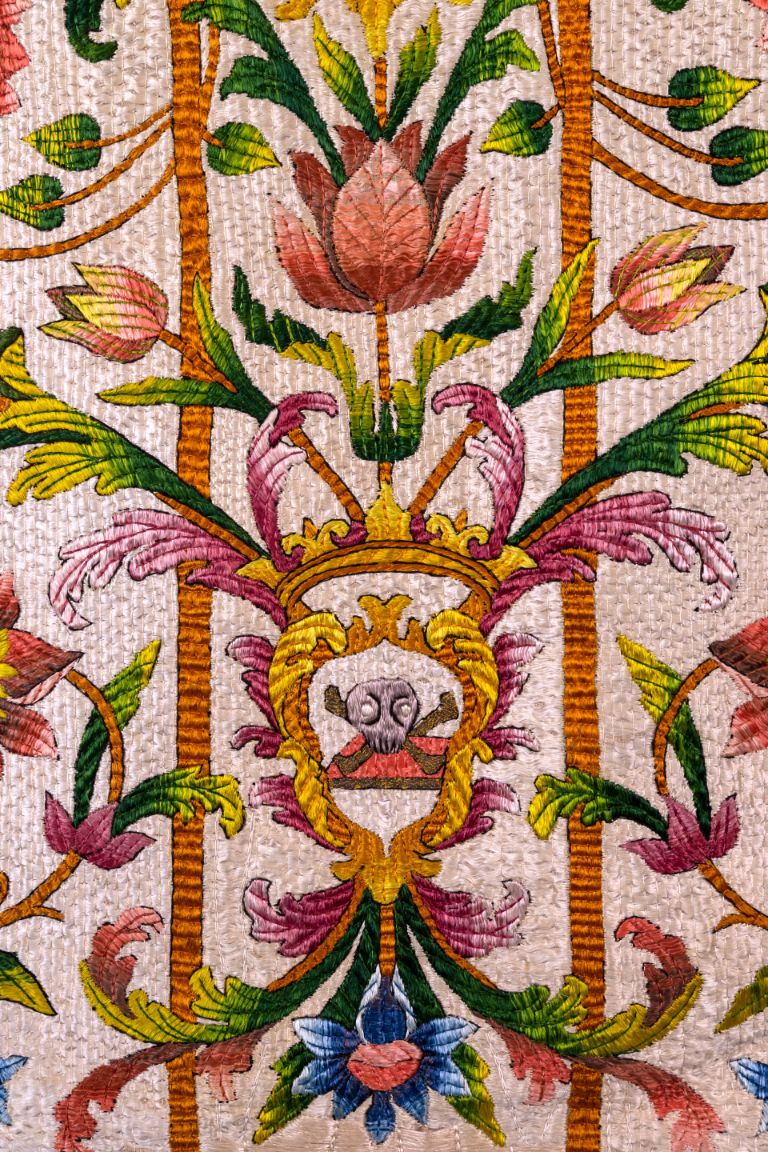

🗓 XVIII secolo
📍 Sicilia, forse Agrigento
🏆 Cm 120x70
Questo splendido parato, mancante solo del velo di calice, e’ realizzato totalmente in seta finissima da una manifattura siciliana alla fine del 1700. Analizzando il motivo della decorazione si puo’notare come i ricami, a girali floreali, partano dallo stemma recante un teschio.
Sicuramente il parato era utilizzato per la celebrazione relativa il culto dei morti, probabilmente il Triduo dei Morti, e la maestosita’ dei ricami fanno supporre alla committenza forse della stessa confraternita’ che curava questa celebrazione. Il parato e’ in perfetto stato di conservazione perche’ durante il passato ha subito un lavoro di rinforzo dei ricami con cuciture, con filo neutro, dall’alto verso il basso, ma soprattutto per la stessa tecnica utilizzata.
Sulla parte interna di canapa, che rende rigido e indossabile il paramento, sono state stese matassine di seta, vincolate alla canapa stessa con punti di cucitura verticali, quindi a differenza degli altri ricami fatti su superficie di raso di seta, o di moir di seta, qui la superficie non e’ un tessuto unico. Sopra queste matassine, trattenute con cuciture verticali, sono stati ricamati in seta, in maniera simmetrica fiori e alcune croci.
Nella parte anteriore del parato si puo’ notare come sia stato restaurato il ricamo che rappresenta una viola mammola. I fiori presentano un accostamento delle sete molto delicato, che sottolinea ancora di piu’ come la manifattura che ha prodotto questo paramento sia stata davvero importante. Lo stato di consevazione e’ buono, ed e’ ancora in utilizzo per il Triduo di Morti di Sant’Antonio ad Hamilton.
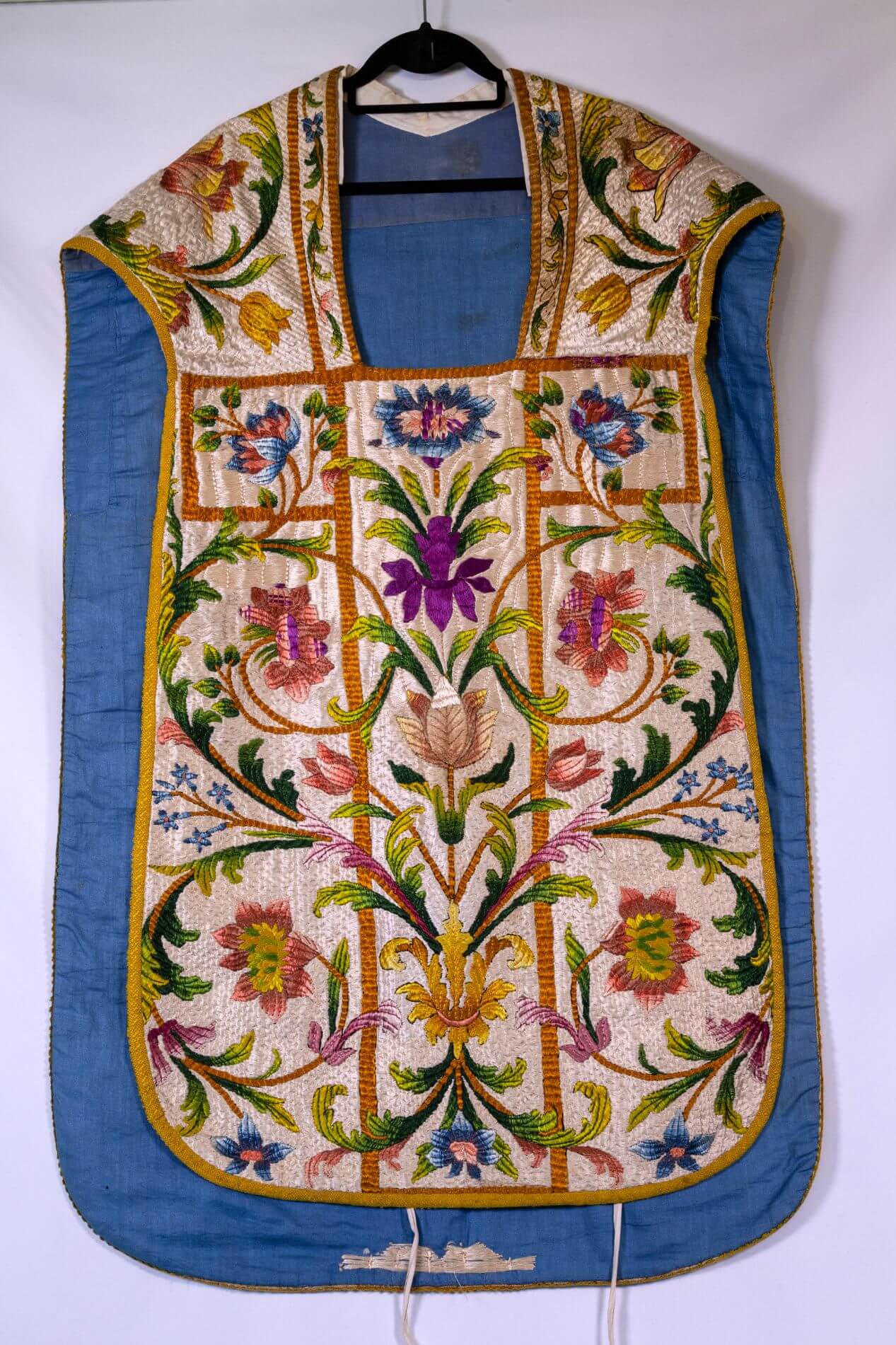

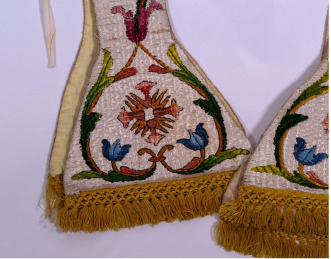

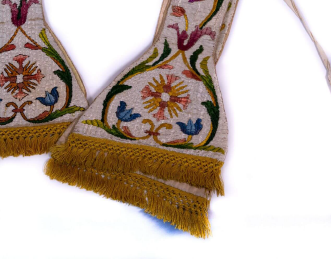

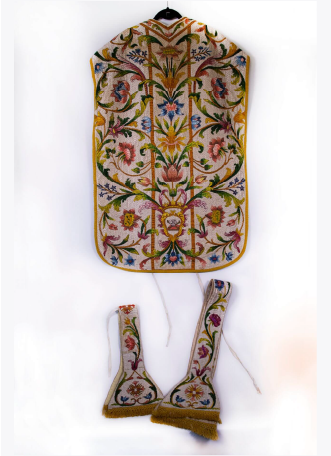

This art exhibit has been organized by Father Francesco Cucchi with artwork items from private collections.
Immerse yourself in the beauty of Italian artisan works that were created by artists that are well-known, not so well-known and in some cases are unknown.
The Exhibit features Italian style artworks from the 16thto 20thcentury.
Sign up to our mailing list to be the first to get notifications of contests, events and news.